Novatel Wireless GSM0308 Wireless Modem User Manual Guide
Novatel Wireless Inc. Wireless Modem Guide
Contents
- 1. Manual
- 2. User Manual
User Manual
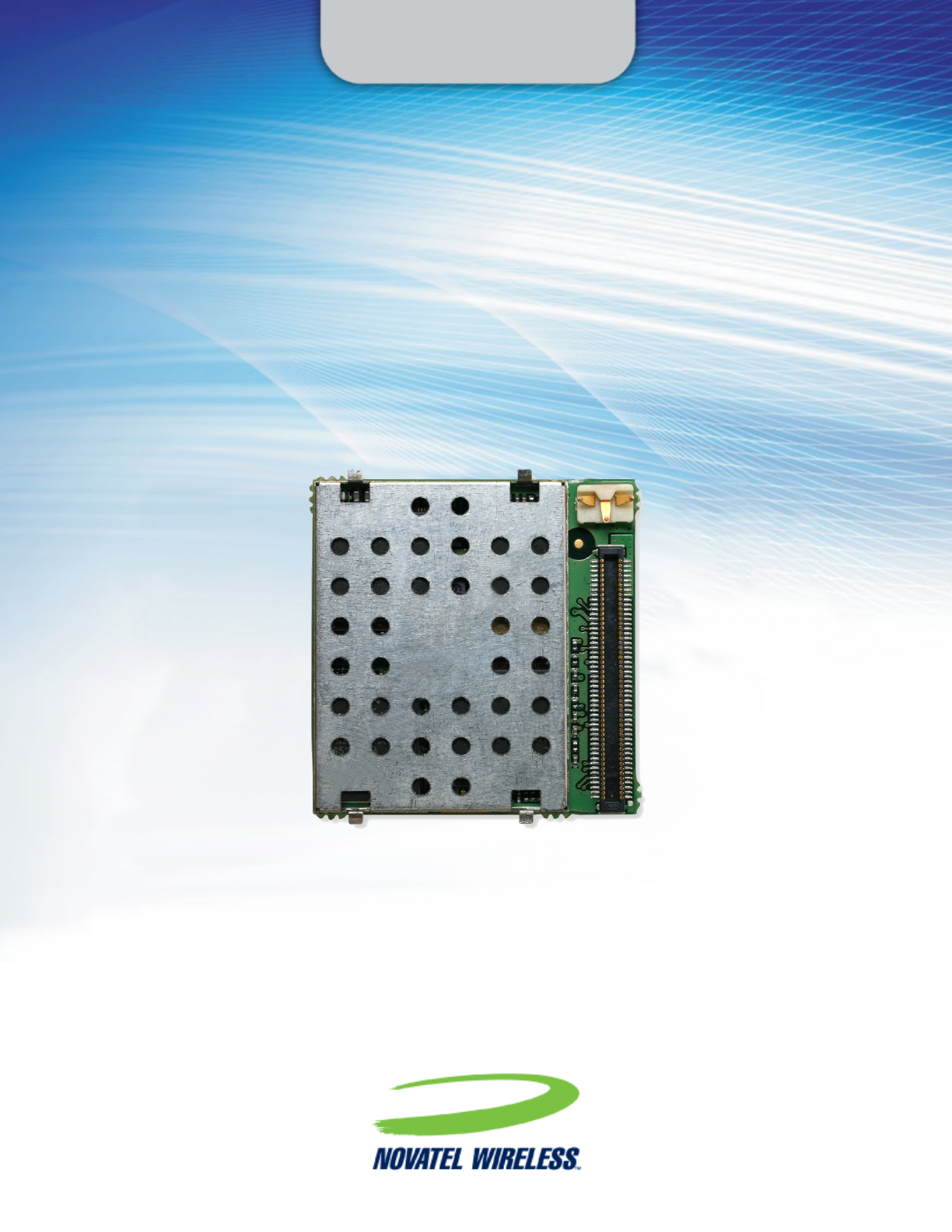
GSM030XIG002
Enabler IIIG
Integration Guide
Version: 3.01 13 November, 2013

i novatelwireless.com
General
TERMS OF USE OF NEW MATERIALS - PLEASE READ CAREFULLY
From time to time, Novatel Wireless, in its sole discretion, may make available for download
on its website (www.novatelwireless.com), or may transmit via mail or email, updates or
upgrades to, or new releases of, the firmware, software or documentation for its products
(collectively, 'New Materials'). Use of such New Materials is subject to the terms and
conditions set forth below, and may be subject to additional terms and conditions as set forth
in Novatel Wireless's Technical Support Policy (posted on its website) and/or any written
agreement between the user and Novatel Wireless.
All New Materials are provided AS IS. Novatel Wireless makes no warranty or representation
with respect to the merchantability, suitability, functionality, accuracy or completeness of any
such New Materials. The user of such New Materials assumes all risk (known or unknown) of
such use. Novatel Wireless reserves all rights in such New Materials. The user shall have only a
revocable and limited license to use such New Materials in connection with the products for
which they are intended. Distribution or modification of any New Materials without Novatel
Wireless's consent is strictly prohibited.
IN NO EVENT WILL NOVATELWIRELESS BE RESPONSIBLE FOR ANY INCIDENTAL,
INDIRECT, CONSEQUENTIAL OR SPECIAL DAMAGES AS A RESULT OF THE USE OF ANY
NEW MATERIALS. NOVATELWIRELESS 'S MAXIMUM LIABILITY FOR ANY CLAIM BASED
ON THE NEW MATERIALS SHALL NOT EXCEED FIFTY U.S. DOLLARS ($50).
Version Verification
Please ensure you have the latest version of this document by downloading it from
www.novatelwireless.com
ii novatelwireless.com
Copyright
© 2013 Novatel Wireless. All rights reserved. Complying with all applicable copyright laws is
the responsibility of the user. Without limiting the rights under copyright, no part of this
document may be reproduced, stored in or introduced into a retrieval system, or transmitted
in any form or by any means (electronic, mechanical, photocopying, recording or otherwise),
or for any purpose, without the express written permission of Novatel Wireless.
Novatel Wireless and the Novatel Wireless logo are either registered trademarks or
trademarks of Novatel Wireless, Inc. in the United States.
251 Renner Pkwy
Richardson, TX 75080 USA
Phone: (972) 633-4400
Fax: (972) 633-4444
Email: info@nvtl.com
www.novatelwireless.com
iii novatelwireless.com
Warranty Information
[Revised: 11/11/2010]
This warranty applies to (a) products sold directly by Novatel Wireless M2M, unless a different
warranty is specified in a written agreement between Novatel Wireless M2M and the
purchaser; and (b) products sold to end users through a distributor authorized by Novatel
Wireless M2M, but only where the authorized distributor does not provide a separate
warranty on such products, and Novatel Wireless M2M has agreed to provide this warranty to
such end users. If you purchased the product from an authorized distributor, please check
whether this warranty from Novatel Wireless M2M, or a separate warranty from the
distributor, applies to your purchase. This warranty does not apply to any (i) accessories or
batteries for the products; or (ii) demonstration samples or prototypes of the products. Unless
otherwise provided in a written agreement between Novatel Wireless M2M and the
purchaser, all such accessories, batteries, samples or prototypes are provided by Novatel
Wireless M2M AS IS without any warranty of any kind.
Novatel Wireless M2M warrants to the original purchaser of the product from Novatel
Wireless M2M or its authorized distributor (as applicable) that, for a period of one (1) year
from the date of shipment of the product from Novatel Wireless M2M, the product hardware
will be substantially free from defects in material or workmanship under normal operation, and
the product firmware will perform substantially in accordance with the product
documentation provided by Novatel Wireless M2M. Novatel Wireless M2M does not warrant
that (a) the product hardware or firmware will meet the purchaser's requirements; (b) the
operation of the product hardware or firmware will be uninterrupted or error-free; or (c) the
product, when integrated in, or combined with, other products or software not supplied by
Novatel Wireless M2M, will continue to perform substantially in accordance with the product
documentation. This limited warranty is for the benefit of the original purchaser, and is not
transferable.
During the warranty period, Novatel Wireless M2M, at its expense and in its sole discretion,
will repair the product, or replace the product with a corresponding or equivalent product, if
it is determined to have a covered defect, provided that the purchaser first notifies Novatel
Wireless M2M (directly or through its authorized distributor from which the product was
purchased) of any such defect, furnishes Novatel Wireless M2M with a proof of purchase (if
required), requests and obtains a return merchandize authorization (RMA) number from
Novatel Wireless M2M, and returns the product under that RMA to Novatel Wireless M2M (or,
at Novatel Wireless M2M's option, to its authorized distributor), with the shipping charges
being prepaid by purchaser. If, upon reasonable examination of the returned product, Novatel
Wireless M2M does not substantiate the defect claimed by purchaser, or determines that the
defect is not covered under this limited warranty, Novatel Wireless M2M will not be required
to repair or replace the product, but may instead reship the product to the purchaser (or, at
Novatel Wireless M2M's option, to its authorized distributor where the product can be made
iv novatelwireless.com
available to purchaser), in which case the purchaser shall be responsible for paying Novatel
Wireless M2M's cost for reshipping the product to purchaser (or to Novatel Wireless M2M's
authorized distributor), and Novatel Wireless M2M's usual charges for unpacking, testing, and
repacking the product for reshipment to purchaser (or to Novatel Wireless M2M's authorized
distributor).Purchaser shall bear the risk of loss or damage in transit to any product returned
by purchaser to Novatel Wireless M2M, or any returned product not found to be defective or
covered under this warranty, and reshipped by Novatel Wireless M2M to purchaser (or to
Novatel Wireless M2M's authorized distributor). In the event Novatel Wireless M2M repairs or
replaces a defective product covered by this limited warranty, the repaired or replacement
product will be covered under this limited warranty for the remainder of the original warranty
period on the defective product, or a period of ninety (90) days, whichever is longer. If
Novatel Wireless M2M is unable to repair or replace a defective product covered by this
limited warranty, Novatel Wireless M2M will provide to purchaser a credit or a refund (at
Novatel Wireless M2M's option) of the original purchase price (excluding taxes and shipping
charges). Any returned and replaced product, or any product for which Novatel Wireless M2M
has furnished a credit or a refund, becomes the property of Novatel Wireless M2M.
Novatel Wireless M2M shall not have any obligation to provide any firmware bug fixes,
upgrades or new releases except as may be necessary to correct any covered defect of which
purchaser notifies Novatel Wireless M2M in writing during the warranty period. Novatel
Wireless M2M, from time to time and in its sole discretion, may make available for download
on its website (www.novatelwireless.com), or may provide via email, certain firmware bug
fixes, upgrades or new releases for the product. Download and use of any such bug fixes,
upgrades or new releases is subject to all of the applicable terms and conditions of Novatel
Wireless M2M's technical support policy as posted and updated on its website.
Novatel Wireless M2M shall have no obligation under this limited warranty for (a) normal wear
and tear; (b) the cost of procurement of substitute products; or (c) any defect that is (i)
discovered by purchaser during the warranty period but for which purchaser does not
request an RMA number from Novatel Wireless M2M, as required above, until after the end of
the warranty period, (ii) caused by any accident, misuse, abuse, improper installation,
handling or testing, or unauthorized repair or modification of the product, (iii) caused by use
of any materials not supplied by Novatel Wireless M2M, or by use of the product other than in
accordance with its documentation, or (iv) the result of electrostatic discharge, electrical
surge, fire, flood or similar causes.
The purchaser (or its customers, as applicable) shall be solely responsible for the proper
configuration, testing and verification of the Novatel Wireless M2M product prior to
deployment in the field, and for ensuring that any end user product or system into which the
Novatel Wireless M2M product is integrated or incorporated operates as intended and meets
the requirements of purchaser (or its customers). Novatel Wireless M2M shall have no
responsibility whatsoever for the integration, configuration, testing, verification, installation,
upgrade, support or maintenance of any such end user product or system, or for any liabilities,
damages, costs or expenses associated therewith.
v novatelwireless.com
Novatel Wireless M2M'S SOLE RESPONSIBILITY AND PURCHASER'S SOLE REMEDY UNDER
THIS LIMITED WARRANTY SHALL BE FOR Novatel Wireless M2M TO REPAIR OR REPLACE
THE PRODUCT (OR IF REPAIR OR REPLACEMENT IS NOT POSSIBLE, PROVIDE A CREDIT
OR REFUND OF THE PURCHASE PRICE) AS PROVIDED ABOVE. Novatel Wireless M2M
EXPRESSLY DISCLAIMS ALL OTHER WARRANTIES OF ANY KIND, EXPRESS OR IMPLIED,
INCLUDING WITHOUT LIMITATION ANY IMPLIED WARRANTIES OF NON-INFRINGEMENT,
MERCHANTABILITY, SATISFACTORY PERFORMANCE AND FITNESS FOR A PARTICULAR
PURPOSE. IN NO EVENT SHALL Novatel Wireless M2M BE LIABLE FOR ANY INDIRECT,
SPECIAL, EXEMPLARY, INCIDENTAL OR CONSEQUENTIAL DAMAGES (INCLUDING
WITHOUT LIMITATION LOSS OR INTERRUPTION OF USE, DATA, REVENUES OR PROFITS)
RESULTING FROM A BREACH OF THIS WARRANTY OR BASED ON ANY OTHER LEGAL
THEORY, EVEN IF Novatel Wireless M2M HAS BEEN ADVISED OF THE POSSIBILITY OR
LIKELIHOOD OF SUCH DAMAGES.
Some jurisdictions may require a longer warranty period than specified above and,
accordingly, for products sold in those jurisdictions the applicable warranty period shall be
extended as required under the laws of those jurisdictions. Furthermore, some jurisdictions
may not allow the disclaimer of implied warranties or the exclusion or limitation of incidental
or consequential damages, so the above disclaimer, limitation or exclusion may not apply to
products sold in those jurisdictions. This limited warranty gives the purchaser specific legal
rights and the purchaser may have other legal rights that vary from jurisdiction to jurisdiction.
This limited warranty shall be governed by the laws of the State of Texas, United States of
America, without regard to conflict of laws principles. This limited warranty shall not be
governed in any respect by the United Nations Convention on Contracts for the International
Sale of Goods.
vi novatelwireless.com
Regulatory Compliance
This section summarizes the responsibilities and actions required of manufacturers and
integrators who incorporate OEM versions of the Novatel Wireless M2M Enabler IIIG module
into their products. In certain situations and applications, these products will require
additional FCC, CE, GCF, PTCRB or other regulatory approvals prior to sale or operation.
Appropriate instructions, documentation and labels are required for all products. For more
information concerning regulatory requirements, please contact Novatel Wireless M2M.
GCF/PTCRB Approval (Formerly FTA)
The Novatel Wireless M2M Enabler IIIG module is type approved in accordance with the
requirements of and through the procedures set forth by the GSM industry association. The
relevant conformance specification is 3GPP TS 51010-1. Any OEM changes in the SIM interface,
antenna port, software or the physical makeup of the unit may require an incremental FTA to
ensure continued compliance with the above-mentioned standard. For more information
concerning type approval, please contact Novatel Wireless M2M.
FCC Certification
Novatel Wireless M2M certifies that the Novatel Wireless M2M Enabler IIIG
850/900/1800/1900 MHz GSM Radio Module (FCC ID: MIVGSM0308) complies with the RF
requirements applicable to broadband PCS equipment operating under the authority of 47
CFR Part 24, Subpart E and Part 22 of the FCC Rules and Regulations. This certification is
contingent upon installation, operation and use of the Novatel Wireless M2M Enabler IIIG
module and its host product in accordance with all instructions provided to both the OEM and
end user. When installed and operated in a manner consistent with the instructions provided,
the Novatel Wireless M2M Enabler IIIG module meets the maximum permissible exposure
(MPE) limits for general population / uncontrolled exposure at defined in Section 1.1310 of the
FCC Rules and Regulations.
The Enabler IIIG modem is designed for use in a variety of host units, "enabling" the host
platform to perform wireless data communications. However, there are certain criteria relative
to integrating the modem into a host platform such as a PC, laptop, handheld, monitor and
control unit, etc. that must be considered to ensure continued compliance with FCC
compliance requirements. Please follow this next section when integration this modem to
ensure compliance with the FCC and IC rules.
M2M Module Installation and Collocation Guidelines
FCC and IC Approval Process for Host Devices
FCC and IC Integrations are covered through two possible approaches.

vii novatelwireless.com
1) New grant
Labeling: A single ‘New’ FCC ID covers the host and the integrated module.
In this approach the host manufacturer will have the system (host and module) evaluated to
all the applicable FCC requirements. A new FCC ID is obtained to cover this assessment. This
option is the responsibility of the host manufacturer.
2) Class I or a Class II permissive change
Labeling: The Enfora/Novatel Wireless FCC ID appears on the host device.
This section provides module and antenna installation guidelines for host devices to be
authorized for use with the (M2M module here) module through the FCC Class I or Class II
Permissive Change process. As the grantee Enfora/Novatel Wireless is responsible for all
integrations and must be consulted on all regulatory matters involving the GSM0308.
The module was originally granted by the FCC as a single modular approval. The technical
specifications of the integrations will determine the scope of work to cover the integrations.
1) The M2M module can be installed as a standalone transmitter in devices as a Class I
permissive change meeting the following conditions:
a. >20cm separation distance is provided between the M2M transmitting antenna
and the end user at all times.
b. All other intentional radiators within the host device must be evaluated:
i. An antenna location diagram for the host device must be provided,
showing locations of all transmitting antennas and the separation
distance of other transmitting antennas from the M2M antenna
ii. A list of FCC ID’s for all collocated transmitters must be provided.
iii. Datasheets for all collocated transmitting antenna(s) must be
provided, showing manufacturer part number, and peak gain (dBi)
c. The host PCB trace that carries the RF from the module to the external antenna
connector must be evaluated against the design guides. Strict adherence to the
design parameters in the design guides must be observed for a Class I permissive
change to be considered.
d. The antenna gain cannot exceed the following to qualify as a Class I permissive
change:
i. 850MHz: 4.5dBi
viii novatelwireless.com
ii. 1900MHz: 2.0dBi
e. If the M2M modem is required to provide voice support the design must be
evaluated by Novatel Wireless.
f. The FCC and Industry Canada IDs must be permanently affixed on the exterior of
the notebook or readily accessible under a panel or battery pack of the host device
that cannot be separated from the host device itself.
i. The label must state:
a. This device contains FCC ID: MIVGSM0308
b. This device contains IC: 4160A-GSM0308
g. The user manual/installation guide must give clear instructions regarding the
proper installation and use to ensure compliance with FCC/IC RF Exposure
guidelines, and also include appropriate caution and warning statements and
information
2) The M2M module can be installed as a standalone transmitter in host devices as a Class II
permissive change meeting the following conditions. (Standalone is defined as a single
transmitter transmitting as opposed to 2 or more transmitters transmitting simultaneously.)
a. ≤20cm separation distance is provided between the transmitting antenna and
the end user. This will trigger a SAR measurement or evaluation. The OEM
integrator is responsible to design the product to comply with RF exposure, and
must work with Novatel Wireless (the grantee) to satisfy FCC/IC SAR
requirements.
b. If the device does not meet the criteria in item #1 for a Class I permissive change
then additional testing with an application to the FCC will be required.
c. Once the Class II permissive change has been completed the FCC and Industry
Canada IDs must be permanently affixed on the exterior of the notebook or readily
accessible under a panel or battery pack of the host device that cannot be
separated from the host device itself.
i. The label must state:
a. This device contains FCC ID: MIVGSM0308
b. This device contains IC: 4160A-GSM0308
ix novatelwireless.com
d. The user manual/installation guide must give clear instructions regarding the
proper installation and use to ensure compliance with RF Exposure guidelines.
Note: The host manufacturer is responsible for all standalone regulatory requirements prior to
the integration of the M2M module (i.e. FCC Part 15 for unintentional radiators).
FCC Notice to Users
Novatel Wireless M2M has not approved any changes or modifications to this device by the
user. Any changes or modifications could void the users authority to operate the device. See
47 CFR Sec. 15.21. The device complies with part 15 of the FCC rules. Operation is subject to
the following two conditions: (1) This device may not cause harmful interference, and (2) this
device must accept any interference received, including interference that may cause
undesired operation. See 47 CFR Sec. 15.19.
This equipment has been tested and found to comply with the limits for a Class B digital
device, pursuant to part 15 of the FCC rules. These limits are designed to provide reasonable
protection against harmful interference in a residential installation. This equipment generates,
uses, and can radiate radio frequency energy and, if not installed and used in accordance with
the instructions, may cause harmful interference to radio communications. However, there is
no guarantee that interference will not occur in a particular installation. If this equipment does
cause harmful interference to radio or television reception, which can be determined by
turning the equipment off and on the user is encouraged to try to correct the interference by
one or more of the following measures:
• Reorient or relocate the receiving antenna.
• Increase the separation between the equipment and receiver.
• Connect the equipment into an outlet on a circuit different from that to which the receiver is
connected.
• Consult the dealer or an experienced radio/TV technician for help.
This device complies with Part 15 of the FCC Rules. Operation is subject to the fol-
lowing two conditions:
(1) This device may not cause harmful interference, and
(2) This device must accept any interference received, including interference that may
cause undesired operation.
Refer to the following for FCC Regulations:

x novatelwireless.com
Internet: http://www.fcc.gov/
l FCC Rules, Part 24
l 47 CFR Subpart E--Broadband PCS
l 47 CFR § 24.52, sections 1.1307(b), 2.1091, and 2.1093
l FCC Rules, Part 22 for GSM 850
l FCC Rules, Part 15
l FCC Rules, Part 2
l Subpart J--Equipment Authorization Procedures
l Section 2.925
FCC Office of Engineering and Technology (OET)
Internet: http://www.fcc.gov.oet/
l Bulletin Number 65 "Evaluating Compliance with FCC Guidelines for Human Exposure
to Radio Frequency Electromagnetic Fields"
l Supplement C "Additional Information for Evaluating Compliance of Mobile and
Portable Devices with FCC Limits for Exposure to Radio Frequency Emissions"
CE Marking - R&TTE Directive
The Enabler IIIG module have been tested and certified to comply with the requirements of
the European Directive 1999/5/EC, the R&TTE Directive. The modules are certified directly
against Article 3.2 of the directive for Radio transceiver aspect. The modules are not directly
certified against Article 3.1a (Safety) and 3.1b (EMC), but are shown to be in compliance
through testing on a typical integrated device utilizing the module. The module is marked
with the CE marked and the notified body number of the reviewing organization as is shown
below.
It is the responsibility of the integrator to ensure that the device incorporating the Enabler IIIG
module is in compliance with the requirements of Article 3.1a (Safety) and 3.1b (EMC), as well
as ensuring that the integrated device remains in compliance with the requirements of Article
3.2 of the directive.
Regulatory Requirements for Other Countries
In most other countries there are similar rules and regulations that may need to be met for
importing the Novatel Wireless M2M Enabler IIIG module and for placing it on the market in
the integrated device. Each country may require a different mark of approval as an
acceptance requirement. For each of these cases the country should identified, and the
appropriate steps should be taken to meet the requirements set forth in the intended market.
xi novatelwireless.com
Industry Canada
Refer to the following for Industry Canada Regulations:
l RSS-132
l RSS-133
l ICES-003
ROHS Compliance
As a part of Novatel Wireless M2M’s corporate policy of environmental protection, Novatel
Wireless M2M takes every step to ensure that the Enabler IIIG modules are designed and
manufactured to comply to the European Union Directive 2002/95/EC for the Restriction of
Hazardous Substances (RoHS).
Environmental Regulations
Refer to the following for Environmental Regulations:
l National Environmental Policy Act (NEPA) of 1969 (Part 1, Subpart 1)
Mechanical Specifications
Refer to the following for RF and EMI Specifications:
l ASTM D999
l ASTM D775
l IEC 68-2-27
l Bellcore Gr-63-CORE
l ETS 300 019-1-1 Class 1.2
l ETS 300 019-1-2 Class 2.1
l ETS 300 019-1-3 Class 3.1
RF And EMI Specifications
Refer to the following for RF and EMI Specifications:
l ETSI Standards
l EN 61000-4-6
l EN 61000-4-3
l 3GPP TS 51.010-1, Section 12.2
l EN 55022 Class B
xii novatelwireless.com
References
Refer to the following sources for more information on the Enabler IIIG:
Manuals
l GSM0308AT001 - Novatel Wireless M2M GSM/GPRS OEM Module AT Command Set
Reference
l GSM0308UG001 - Novatel Wireless M2M GSM-GPRS Family API Reference
l GSM0308SD001 - Enabler IIIG - SDK Guide
Application Notes
l GSM0000AN001 - Enabler-G PPP Configuration for Windows 98
l GSM0000AN002 - Enabler-G PPP Configuration for Windows 2000
l GSM0000AN003 - Enabler-G Data Circuit Switched Call Configuration and Use
l GSM0000AN004 - Enabler-G SMS Configuration and Use
l GSM0000AN005 - Enabler-G Automated Network Connection Configuration and Use
l GSM0000AN006 - Enabler-G Module Status Query
l GSM0000AN007 - Enabler-G Status Reporting
l GSM0000AN008 - Enabler-G PPP Configuration for Windows XP
l GSM0000AN009 - Dynamic IP Assignment Support
l GSM0000AN010 - Enabler-G PPP Configuration for PocketPC 2002
l GSM0000AN011 - PAD Configuration and Use
l GSM0000AN012 - Network Transparency Configuration for PAD
l GSM0000AN013 - Enabler-G Sleep Mode Configuration and Use
l GSM0000AN014 - Anytime PPP API Access
l GSM0000AN015 - Event Monitor and Reporting Overview
l GSM0000AN016 - How to Send SMS Messages to an E-Mail Address
l GSM0000AN017 - SMTP Mail Access via TCP PAD
l GSM0000AN018 - USNO NTP Network Time Service TCP PAD
Technical Notes
l GSM0000TN001 - Enabler-G Firmware Upgrade
l GSM0000TN002 - Enabler-G PPP Negotiation Sequence
l GSM0000TN006 - UDP Wakeup Message Header Decoding
l GSM0000TN008 - Enabler Power Supply Requirements
l GSM0000TN009 - Server Application Design Considerations for Dynamic IP
l GSM0000TN012 – Enabler IIIG Engineering Mode Command Reference
l GSM0000TN013 – Enabler IIIG and IIE CMUX Description
White Papers
l GSM0000WP001 - Enabler-G Differentiation Features
GSM Device Specifications
l 3GPP TS 51010-1 (850, 900,1800,1900 MHz devices)
xiv novatelwireless.com

xv novatelwireless.com
Important Safety Information
The following information applies to the devices described in this manual. Always observe all
standard and accepted safety precautions and guidelines when handling any electrical device.
l Save this manual: it contains important safety information and operating instructions.
l Do not expose the Novatel Wireless M2M Enabler IIIG product to open flames.
l Ensure that liquids do not spill onto the devices.
l Do not attempt to disassemble the product: Doing so will void the warranty. With the
exception of the Subscriber Identification Module (SIM), this product does not contain
consumer-serviceable components.
Disclaimer
The information and instructions contained within this publication comply with all FCC, GCF,
PTCRB, R&TTE, IMEI and other applicable codes that are in effect at the time of publication.
Novatel Wireless M2M disclaims all responsibility for any act or omissions, or for breach of law,
code or regulation, including local or state codes, performed by a third party.
Novatel Wireless M2M strongly recommends that all installations, hookups, transmissions, etc.,
be performed by persons who are experienced in the fields of radio frequency technologies.
Novatel Wireless M2M acknowledges that the installation, setup and transmission guidelines
contained within this publication are guidelines, and that each installation may have variables
outside of the guidelines contained herein. Said variables must be taken into consideration
when installing or using the product, and Novatel Wireless M2M shall not be responsible for
installations or transmissions that fall outside of the parameters set forth in this publication.
Novatel Wireless M2M shall not be liable for consequential or incidental damages, injury to
any person or property, anticipated or lost profits, loss of time, or other losses incurred by
Customer or any third party in connection with the installation of the Products or Customer's
failure to comply with the information and instructions contained herein.
Warning: The Enabler IIIG platform is designed with features to support a robust
connection. There are instances where the module performance is beyond the
control of the intended design. Integrated designs that require 24 by 7 operation
must implement power control via an external circuit or by implementing power
management as specified within this design guide

xvi novatelwireless.com
Table of Contents
1 Introduction 1
Technical Specifications 3
Typical Usage 5
Contacting Novatel Wireless M2M 5
2 Module Power 6
Typical Operating Power 7
3 Physical Interfaces 8
Module Mounting To Host Board (Reference) 12
Connectors 15
Connectors 16
Coaxial Connector Option 16
RF Board-to-Board Connector Option 16
I/O Connector Pin Assignments 17
Circuit Protection 20
Antenna 21
Control Connector Signal Functions 21
Module Power (Pins 85, 87, 89, 91, 93, 95, 97, 99) 21
Power Control (Pin 35) - (PWR_CTL) 22
Turning On The Enabler IIIG 22
Turning Off The Enabler IIIG 23
Using The Power Control Signal 23
Modem Power Switch 25
Level Translation Reference Power (Pin 77) 26
USB (Pins 1, 3, 5, 7, 9) 27
General Purpose Input/Output Interface 27
RTC Sleep 29

xvii novatelwireless.com
Serial Interfaces & Handshake (Pins 11, 13, 15, 17, 19, 21, 23, 25) 29
Ring Indicate (Pin 23) 31
Multi-Channel Serial Interface (MCSI) – (Pins 12, 14, 16, 18) 32
VBackup Input (Pin83) 33
Using VBackup 33
KHZ Output (Pin 56) 34
Analog-to-Digital Input (Pin 74) 34
Handset Microphone Input (Pins 65, 67) 35
Handset Microphone Bias Output (Pin 63) 35
Handset Speaker Output (Pins 71, 73) 35
Headset Microphone Input (Pin 55) 36
Headset Microphone Bias Output (Pin 53) 37
Headset Speaker Output Left & Right (Pins 57, 59) 37
Headset Output Common Mode (Pin 61) 38
Headset Detect (Pin 47) 38
Subscriber Identity Module (SIM) Carrier (Pins 76, 78, 80, 82, 84) 39
Using A Remote SIM With The Novatel Wireless M2M Enabler IIIG Module (PINS 76,
78, 80, 82, 84) 40
Remote SIM Component Information 42
Remote SIM Example 42
4 Hardware Design 44
General Design Guidelines For Using Novatel Wireless M2M GSM Modules 45
Advanced Tips For An RF Friendly Layout 45
Thermal Relief 46
Antenna And RF Signal Trace 48
VBAT Input 49
Audio Reference Design 51
Audio Schematics 51
Enabling The Transmission Modes For The GSM/GPRS Services 53

xviii novatelwireless.com
Voice Communication 53
Circuit-Switched Data 53
SMS: Short Message Services 54
Provisioning The SIM 54
GSM Services Supported By The Novatel Wireless M2M Enabler IIIG Module 54
GPRS Services Supported By The Novatel Wireless M2M Enabler IIIG Module 55
Selecting The GSM Modes Of Operation 55
5 Setup And Initialization 56
General Setup 57
Hyperterminal Configuration For The Enabler IIIG Module 57
Initialization (AT Command Interface) 58
Initial Response To The AT Command 59
Sending An Initialization String To The Enabler IIIG-BGA Module 59
Setting Up The Communication Mode For The Enabler IIIG-BGA Module 60
6 Integration And Testing 61
Integrating The Novatel Wireless M2M Enabler IIIG Module 62
2 novatelwireless.com
Novatel Wireless M2M Enabler IIIG modem is a compact, wireless OEM module that uses the
Global System for Mobile Communications (GSM) and General Packet Radio Service (GPRS)
international communications standard to provide two-way wireless capabilities via GSM
services. The Novatel Wireless M2M Enabler IIIG module is a fully Type-approved GSM/GPRS
device, enabling application-specific, two-way communication and control.
This document defines the electrical, mechanical, and software interfaces of the Enabler IIIG
modem, and provides detailed technical information about streamlining hardware and system
integration.
Technical Specifications
Housing
l Size (L x W x H): 28 x 27 x 2.5 mm
l Weight: < 4.2g w/ SIM Carrier / <3.6g
w/o SIM Carrier
l RF Connector: MCD Coaxial or Board-to-Board
Compressor
Radio
l Air Interface: GSM/GPRS
l Frequency Bands: 850/900 MHz - Class 4 (2 W)
1800/1900 MHz - Class 1 (1 W)
l Sensitivity: -106 dBm (Typical)
l Peak Downlink
Speed:
85.6 kbps
l Peak Uplink Speed: 42.8 kbps
SIM Access
l Remote SIM: 1.8/3 V
l Opt Integrated SIM: Yes, Full-Size
Functionality
l Voice: FR, EFR, HR & AMR
l SMS: Text, PDU, MO/MT, Cell Broad-
cast
Environment
l Operating: -30°C to 85°C
l Compliant: -20°C to 60°C
l Storage: -40°C to 85°C
l Humidity: Up to 95% Non-Condensing
Power
l Operating Voltage: 3.3 - 4.4 V DC
Part Numbers
l Without SIM Carrier: GSM0308-10 (B2B RF),
GSM0308-70 (Micro-Coaxial)
l With SIM Carrier: GSM0308-11 (B2B RF),
GSM0308-71 (Micro-Coaxial)
Interface
l Host Protocols: AT Commands, UDP API,
CMUX, PPP
l Internal Protocols: PPP, UDP API, TCP API, UDP
and TCP (PAD)
l Command Protocol: Novatel Wireless M2M Packet
API, GSM AT Command Set
l GSM/GPRS SMS
Protocol:
MO, MT, CB, Text and PDU
Modes
l Packet Data Transfer
Protocol:
GPRS Release 97 and 99
l Coding Schemes: CS1-CS4
l Multi-Slot Capability: MS10 (4RX/2TX) (Max 5
Slots)
l Packet Channel
Support
PBCCH/PCCCH
l API Control/Status: AT Commands, UDP API, TCP
API, AT Commands Over SMS
l Physical Interface: 1 serial (primaryDefault rate
auto baud), I USB (debug)
MCSI (PCM Audio Only)
UART
l Peripheral Interface: 8 Programmable I/O (Expand-
able to 20), 1 Analog Input, 3
Audio (1 Digital Audio)
l Data Input/Output : 100-Position 0.4mm Pitch
Connector
l Primary Serial Port: V.24 Portocol, 1.8V Levels,
Full 9-Pin, UART Imple-
mentation
l USB Port: USB Debug Only (Novatel
Wireless M2M Use Only)
l GPIO: Up to 20 GPIO
l Audio: Digital Audio via MCSI Port
l Voice: Supports 4 Vocoder Modes:
FR, EFR, HR, and AMR
l Speech Codec EFR, FR, HR, AMR
l Antenna Interface: Ultra-Miniature Coaxial Inter-
connect (MCD) or B2B
Spring Contact
l Command Protocol: Novatel Wireless M2M Packet
l Subscriber
Identification Module
(SIM):
Optional 1.8/3 V Mini-SIM car-
rier and interface on board
with SIM detect
l Optional Remote
SIM:
Accessible via the 100-pin
connector
l Voltage Backup: Pin available to maintain RTC
l Reference Clock: 32 KHz & 13 MHz. Output ref-
erence clocks (via 100-pin
connector)
l ADC: 1 ADC port
Certifications
Book Title
Audio Features
l Handset Microphone Biasing:
l Headset Microphone Biasing
l Headset Plug/Unplug Detection
l Headset Hook Detection (Call answer/end button on
equipped Headset microphone device)
l Handset earphone outputs (EARP, EARN pins)
l High-output dynamic differential Earphone mode
(uses Headset outputs)
l Pop Noise attenuation circuitry implemented for all
single-ended output stages
l Handset microphone input (MICIN, MICIP pins)
l Headset microphone input (HSMIC pin)
l Headset 32 stereo outputs (HSOL, HSOR pins)
Packet Data Transfer
l Operating: -30°C to 85°C
l Compliant: -20°C to 60°C
l Storage: -40°C to 85°C
l Humidity: Up to 95% Non-Condensing
l FCC: Parts 15, 22, & 24
l GCF: Version 3.27.0
l PTCRB: Version 5.6
l CE: Yes
l Industry Canada: RSS-210, 132, 133
l RoHS Compliant: Yes

Typical Usage
The following applications can use the Novatel Wireless M2M Enabler IIIG module for
transmitting/receiving data/voice:
l Automated Meter Reading (AMR)
l Point of Sale Applications (POS)
l E-mail and Internet access
l Automated Vehicle Location (AVL)
l Machine-to-Machine communication (M2M)
l Telematics
l Telemetry
l Wireless Security
l Smart Phones
l Telemedicine
Contacting Novatel Wireless M2M
For technical support and customer service dealing with the modem itself, contact the
company where you purchased the product. If you purchased the product directly from
Novatel Wireless M2M, visit the SUPPORT page on the Novatel Wireless M2M web site:
www.novatelwireless.com
1 Introduction

7 novatelwireless.com
Typical Operating Power
GSM Operation
GSM 850/900 (1 RX/1 TX, full power) 250 mA average, 1.6 A peak
GSM 1800 (1 RX/1 TX, full power) 215 mA average, 1.3 A peak
GSM 1900 (1 RX/1 TX, full power) 204 mA average, 1.2 A peak
Idle <2.5 mA Average in DFX 5
Shutdown <50uA
Vbat = 3.7V, Vbak=Vbat, current = 48uA
Vbat = 3.7V, Vbak=0V, current = 45uA
Vbat = 0V, Vbak=3.7V, current=6uA
GPRS Operating Power
EGSM 850.900 (4 RX/1 TX, full power) 272 mA average, 1.6 A peak
EGSM 850/900 (2 RX/2 TX, full power) 420 mA average, 1.6 A peak
GSM 1800 (4 RX/1 TX, full power) 242 mA average, A peak
GSM 1800 (2 RX/2 TX, full power) 354 mA average, A peak
GSM 1900 (4 RX/1 TX, full power) 235 mA average, A peak
GSM 1900 (2 RX/2 TX, full power) 340 mA average, A peak
Idle <2.5 mA average in DFX 5
Shutdown <50 uA
Vbat = 3.7V, Vbak=Vbar, current = 48uA
Vbat = 3.7, Vbak=0V, current = 45uA
Vbat = 0V, Vbak=3.7V, current = 6uA
GSM Transmit Power
1800/1900 MHz GSM Power Class 1 (30 dBm ± 2 dB @ antenna connection)
850/900 MHz GSM Power Class 4 (33 dBm ± 2 dB @ antenna connection)
GSM/GPRS Receiver Sensitivity (Typical)
1800/1900 MHz <-106 dBm, GPRS Coding Scheme 1 (CS1)
850/900 MHz <-106 dBm, GPRS Coding Scheme 1 (CS1)
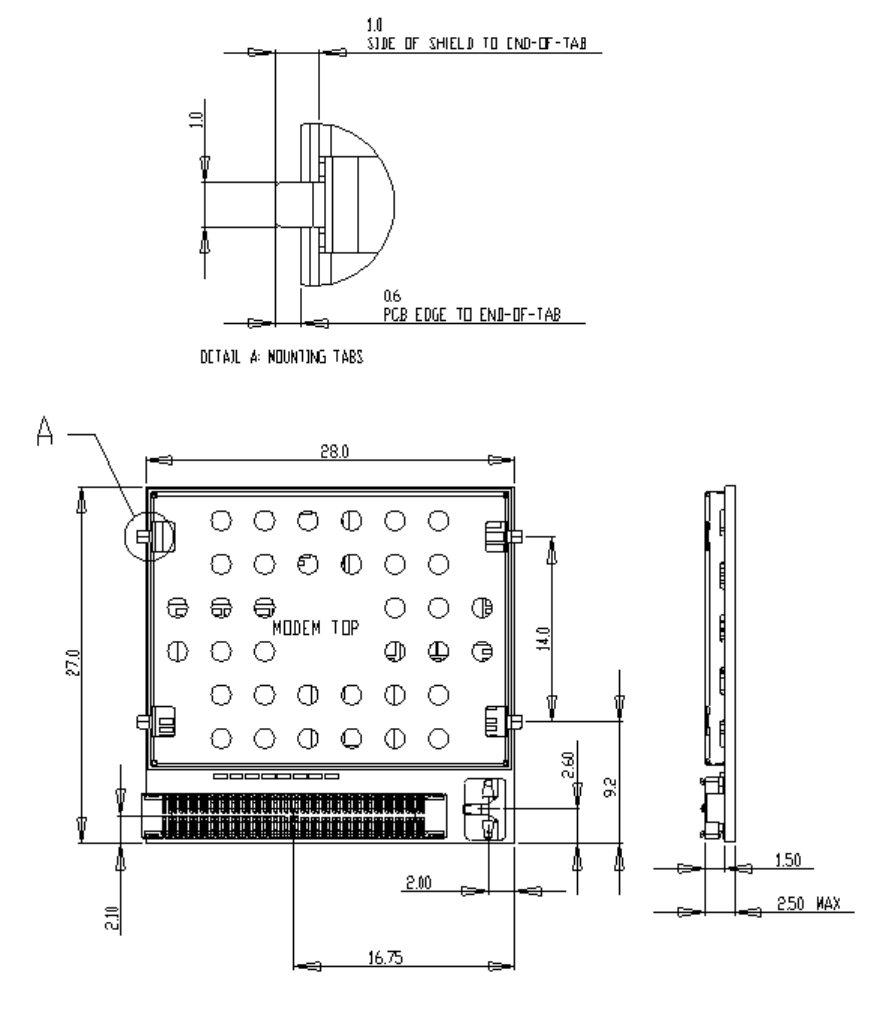
9 novatelwireless.com
Figure 3-1 Front of Module (Board-to-Board RF Conn. Version)
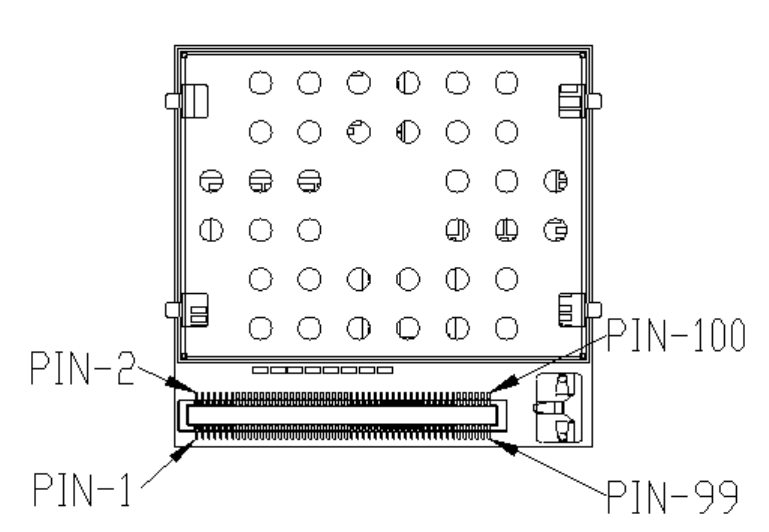
10 novatelwireless.com
Figure 3-2 Pin 1 Reference, 100-Pin I/O Connector
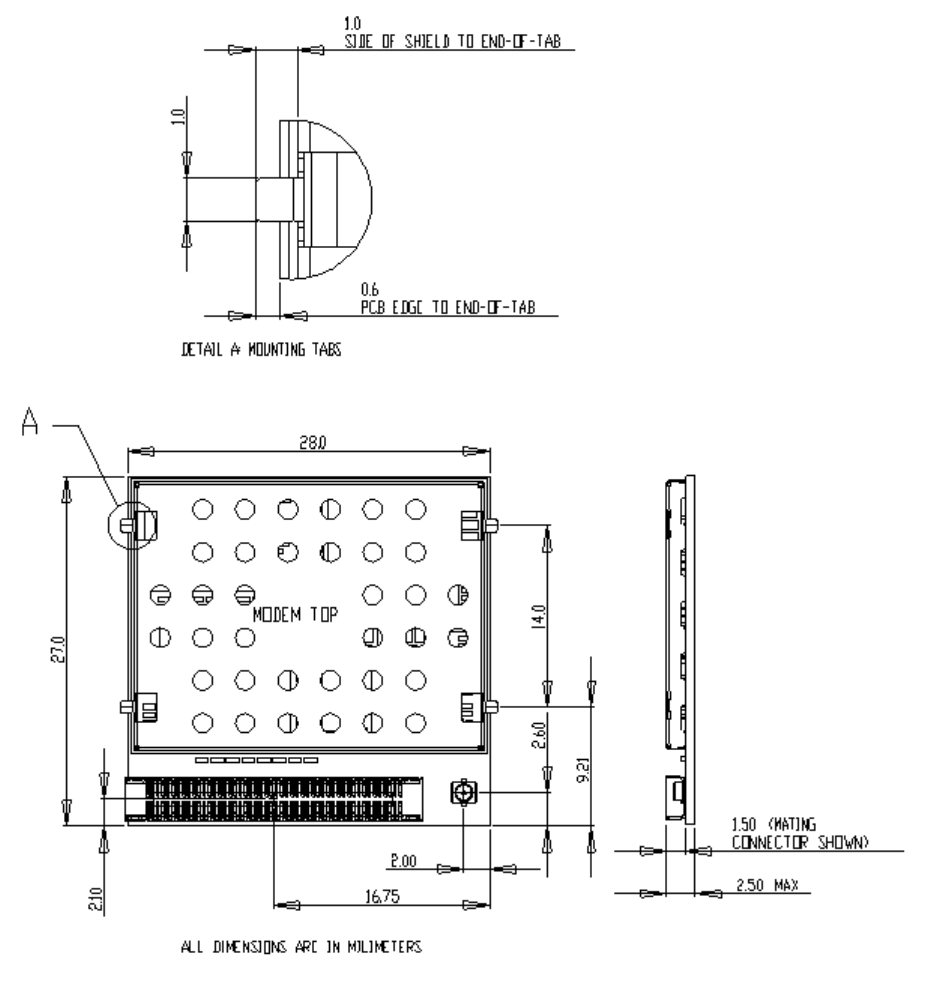
11 novatelwireless.com
Figure 3-3 Front of Module (Coaxial RF Conn. Version)
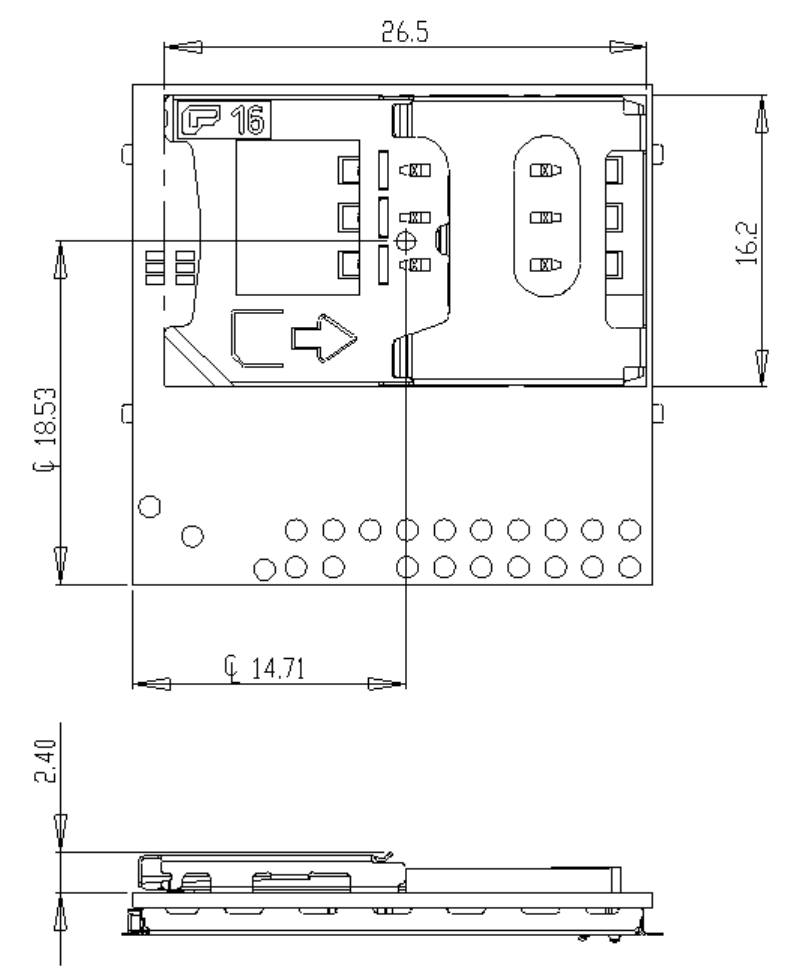
12 novatelwireless.com
Figure 3-4 Back of Module (Option SIM Shown)
Module Mounting To Host Board (Reference)
The module provides mounting tabs that must be soldered to a PCB. These tabs provide
circuit grounding for the module.
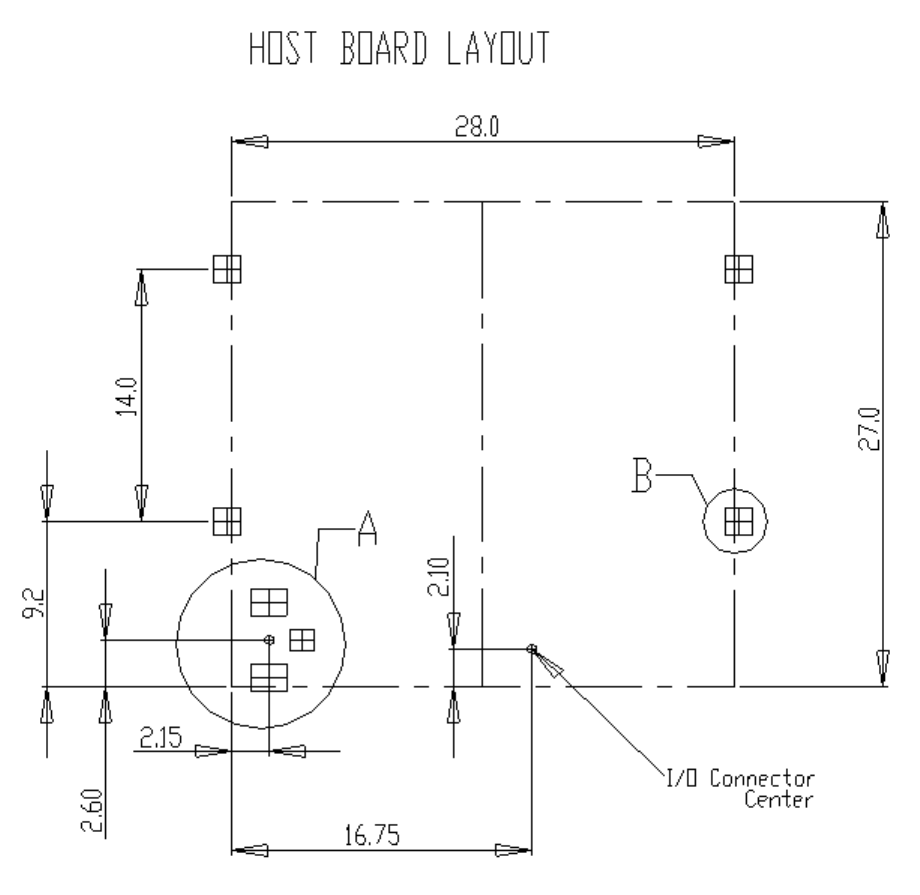
13 novatelwireless.com
Figure 3-5 Module Mounting
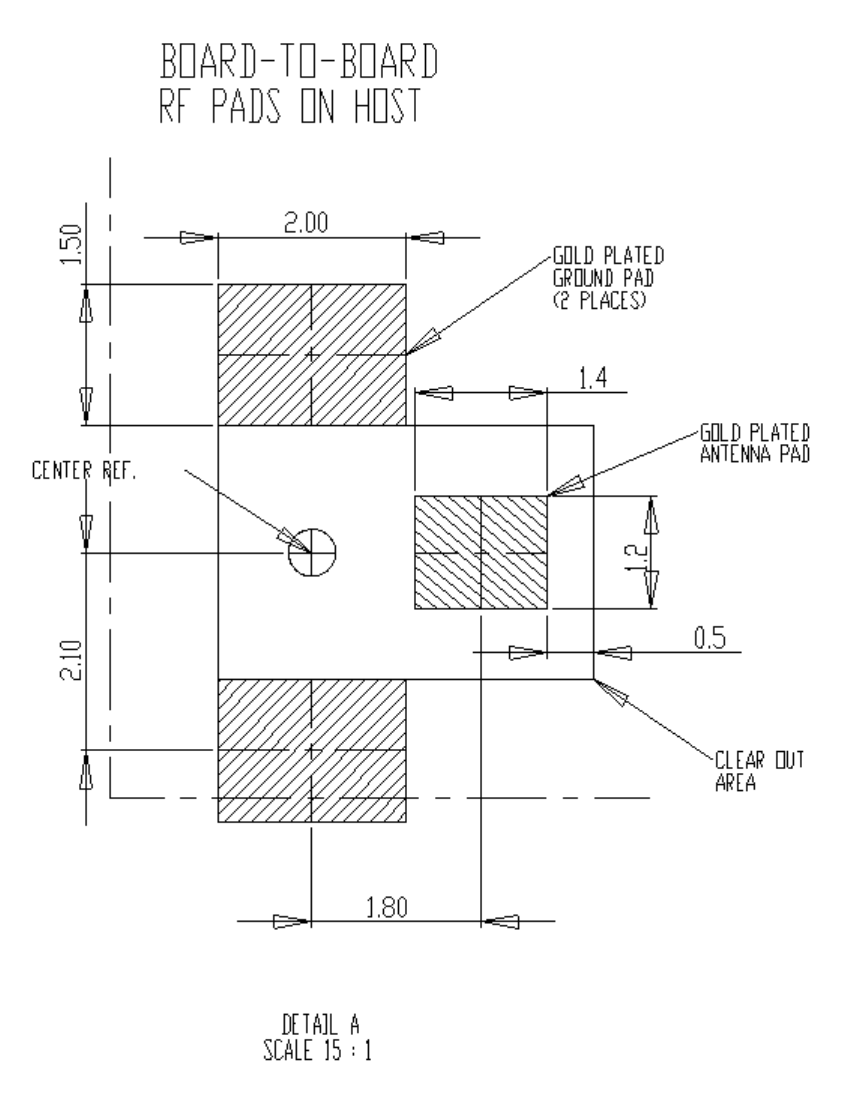
14 novatelwireless.com
Figure 3-6 Host Pads for Board-To-Board RF Connector
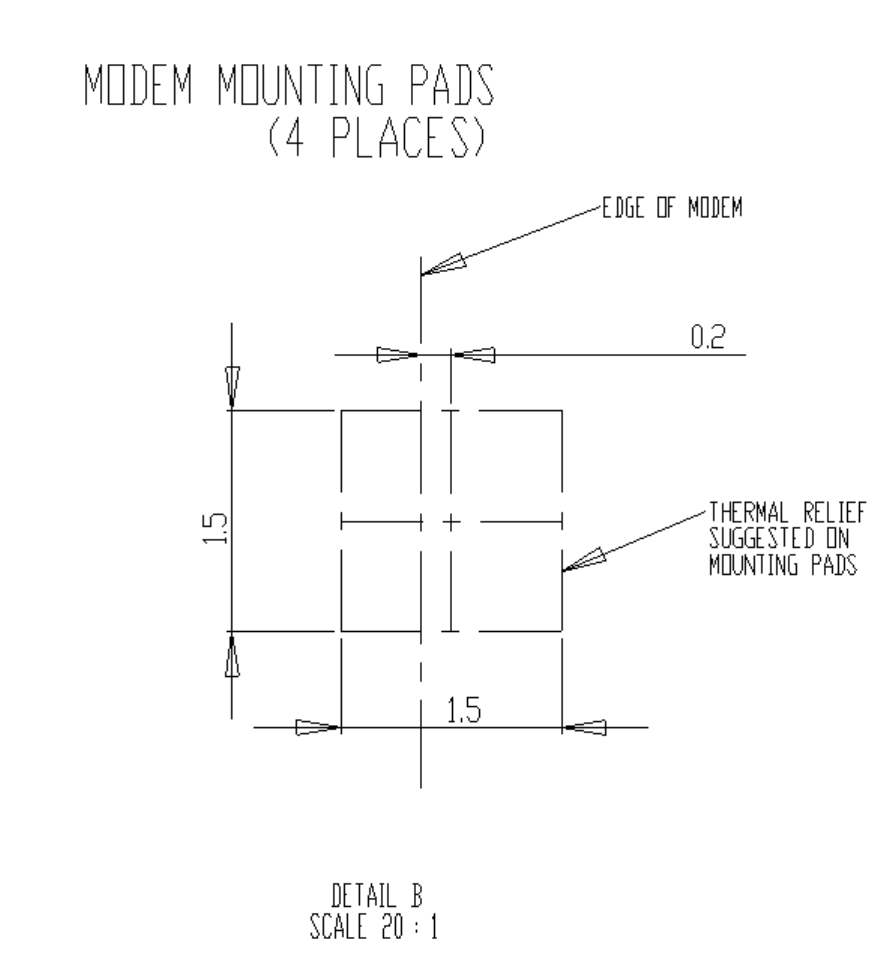
15 novatelwireless.com
Figure 3-7 Modem Mounting Pads
Connectors
On The Modem: 100-Pin I/O Connector, Plug, SMT, Dual Row, 0.4 mm Pitch
Novatel Wireless M2M PN = CON-1040-0100
Molex PN = 55909-1074
16 novatelwireless.com
On The Host: 100-Pin I/O Connector, Socket, SMT, Dual Row, 0.4 mm Pitch (Mate to module)
Novatel Wireless M2M PN = CON-1040-0101
Molex PN = 51338-1074
The mated height of the two connectors is 1.50 mm.
Connectors
The following sections describe connection options:
Coaxial Connector Option
On The Modem:
Sunridge MCD Series – Ultimate Miniature Coaxial Interconnect, 1.55mm Mated Height
Contact Sunridge for mating cable options:
Novatel Wireless M2M PN = CON-0009-0005
Sunridge PN = MCD-ST-00T
http://sunridgecorp.com/
Sunridge Corporation
2500 E. Foothill Blvd. Suite 107
Pasadena, CA 91107
U. S. A.
Tel: (626) 535-1780
Fax: (626) 535-1788
RF Board-to-Board Connector Option
On The Modem:
Novatel Wireless M2M PN = CON-0009-0006
Sunridge PN = MCE-15A-G01
On The Host PCB:
No connector required. See Figure for layout details.

17 novatelwireless.com
I/O Connector Pin Assignments
The following table shows the pin assignments for the input/output connector.
Pin # I/O Description/Comments (Default
Function / Secondary Function Notes
1 P VBUS USB power
2 R GND System Ground
3 P VBUS USB power
4 R GND System Ground
5 I/O USB_DP/RXD/
MIC_R 5 V tolerant data plus pin in
USB modes
6 I LED_B LED B sink
7 I/O USB_DM 5 V tolerant data minus pin in USB modes
8 I RESERVED RESERVED
9 I ID_USB USB connector identification
10 O RESERVED RESERVED
11 7 I UART_RTS Request to send
12 I/O MCSI_RX/GPIO12 GPIO12 / MCSI Serial data input
13 8 O UART_CTS Clear to send
14 I/O MCSI_CLK/GPIO9 GPIO9 / MCSI Serial Clock I/O
15 2 O UART_RXD Serial Data Output
16 I/O MCSI_FSYNC/GPIO10 GPIO10 / MCSI Frame Synchronization I/O
17 4 I UART_DTR Data Terminal Ready
18 I/O MCSI_TX / GPIO11 GPIO11 / MCSI Serial Data Output
19 1 O UART_DCD Data carrier detect
20 I/O GPIO18 GPIO18
21 3 I UART_TXD Serial data input
22 I/O GPIO15 GPIO15
23 9 O UART_RING Ring Indicate
24 I/O GPIO16 GPIO16
25 6 O UART_DSR Data Set Ready
26 I/O GPIO14 GPIO14
27 O RESERVED RESERVED
28 I/O GPIO17 GPIO17
29 O RESERVED RESERVED
30 I/O GPIO13 GPIO13
31 O RESERVED RESERVED
32 I/O GPIO20 GPIO20
33 O RESERVED RESERVED

18 novatelwireless.com
Pin # I/O Description/Comments (Default
Function / Secondary Function Notes
34 I/O GPIO19 GPIO19
35 I PWR_CTL External switch-on event (ON Button) with 32-kHz
de-bouncing
36 I RESERVED RESERVED
37 I RESERVED RESERVED
38 I RESERVED RESERVED
39 I RESERVED RESERVED
40 I RESERVED RESERVED
41 O RESERVED RESERVED
42 RESERVED RESERVED
43 RESERVED RESERVED
44 RESERVED RESERVED
45 RESERVED RESERVED
46 RESERVED RESERVED
47 I HST_DET Headset Detect (if not used, can be left floating)
48 O RESERVED RESERVED
49 I RESERVED RESERVED
50 RESERVED RESERVED
51 RESERVED RESERVED
52 RESERVED RESERVED
53 O HSMICBIAS Headset microphone bias
54 R GND System ground
55 I HSMIC Microphone input (Headset)
56 O CLK32K_BUF 32.768 kHz out, only buffered by 10 kΩ resistor
57 O HSOL 32 kΩ headset amplifier Left
58 I/O GPIO_4 GPIO 4
59 O HSOR 32 kΩ headset amplifier Right
60 I/O GPIO_3 GPIO 3
61 O HSOVMID Headset output common mode
62 I/O USB_BOOT/
GPIO_2 GPIO 2
63 O MICBIAS Microphone bias
64 I/O GPIO_1 GPIO 1
65 I MICIP Microphone amplifier positive input (Handset)
66 I/O GPIO_7 GPIO 7
67 I MICIN Microphone amplifier negative input (Handset
68 I/O GPIO_5 GPIO 5
69 R GND System Ground

19 novatelwireless.com
Pin # I/O Description/Comments (Default
Function / Secondary Function Notes
70 I/O GPIO_6 GPIO 6
71 O EARP 33 Ω or 120 Ω speaker amplifier (+) (Analog)
72 I/O GPIO_8 GPIO 8
73 O EARN 33 Ω or 120 Ω speaker amplifier (-) (Analog)
74 I ADCIN4 10-bit A-to-D
75 R GND System Ground
76 PWR VRSIM Output voltage for SIM 1.8 V / 2.85 V
(No Connect
if onboard
SIM holder is
used)
77 PWR VRIO 1.8 V out – Reference for external level trans-
lation
78 O SIM_CLK SIM Card Reference clock
(No Connect
if onboard
SIM holder is
used)
79 RESERVED RESERVED
80 O SIM_RST SIM Card Reference clock
(No Connect
if onboard
SIM holder is
used)
81 RESERVED RESERVED
82 I/O SIM_IO SIM Card I/O Data
(No Connect
if onboard
SIM holder is
used)
83 PWR VBACKUP Backup Battery Voltage
84 I SIMDTC SIM card insertion/extraction detect with 32-kHz
debouncing. (If not used, tie to ground.)
(No Connect
if onboard
SIM holder is
used)
85 P VBAT Power from Host
86 R GND System Ground
87 P VBAT Power from Host
88 R GND System Ground
89 P VBAT Power from Host
90 R GND System Ground
91 P VBAT Power from Host
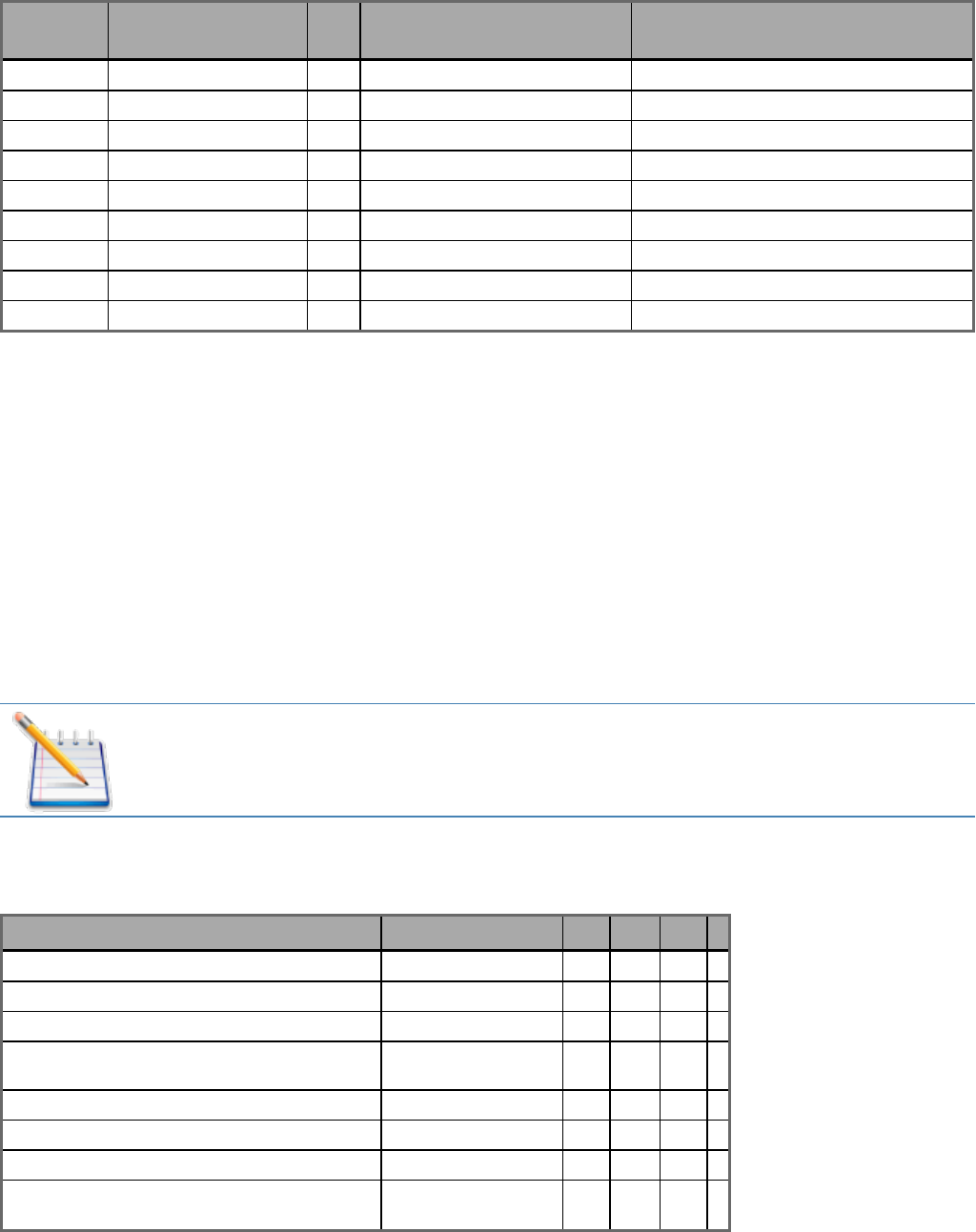
20 novatelwireless.com
Pin # I/O Description/Comments (Default
Function / Secondary Function Notes
92 R GND System Ground
93 P VBAT Power from Host
94 R GND System Ground
95 P VBAT Power from Host
96 R GND System Ground
97 P VBAT Power from Host
98 R GND System Ground
99 P VBAT Power from Host
100 R GND System Ground
Circuit Protection
The module does not have any protection against ESD events or other excursions that exceed
the specified operating parameters (other than very low level ESD protection within the
module’s integrated circuits).
Generally, you should add ESD protection (typically TVS/Transzorb devices) to all signals that
leave the host board. This includes VBAT/VCC.
You can also add series resistors (typically 47 ) in series with data lines to limit the peak
current during a voltage excursion.
Note: Do not add series resistance to the SIM electrical lines.
Minimum ESD Protection Levels ESD/Input Voltage
Pin #’s ESD Test Method Min Nom/
Avg High/
Peak Units
Pins 11 – 24, 26-34, 36, 38, 40, 42, 48, 50, 52, 58, 60,
62, 64, 66,68, 70, 72, 78, 80, 82
Human Body Model
EIA/JEDEC22-A114-A 500 V
Charge Device Model
EIA/JEDEC22-C101-A 200 V
Pins (all VBUS/PWR), 5 – 10, 35, 37, 47, 49, 51, 52, 53,
55 – 57, 59, 61, 63, 65, 67
Human Body Model
EIA/JEDEC22-A114-A
2000 V
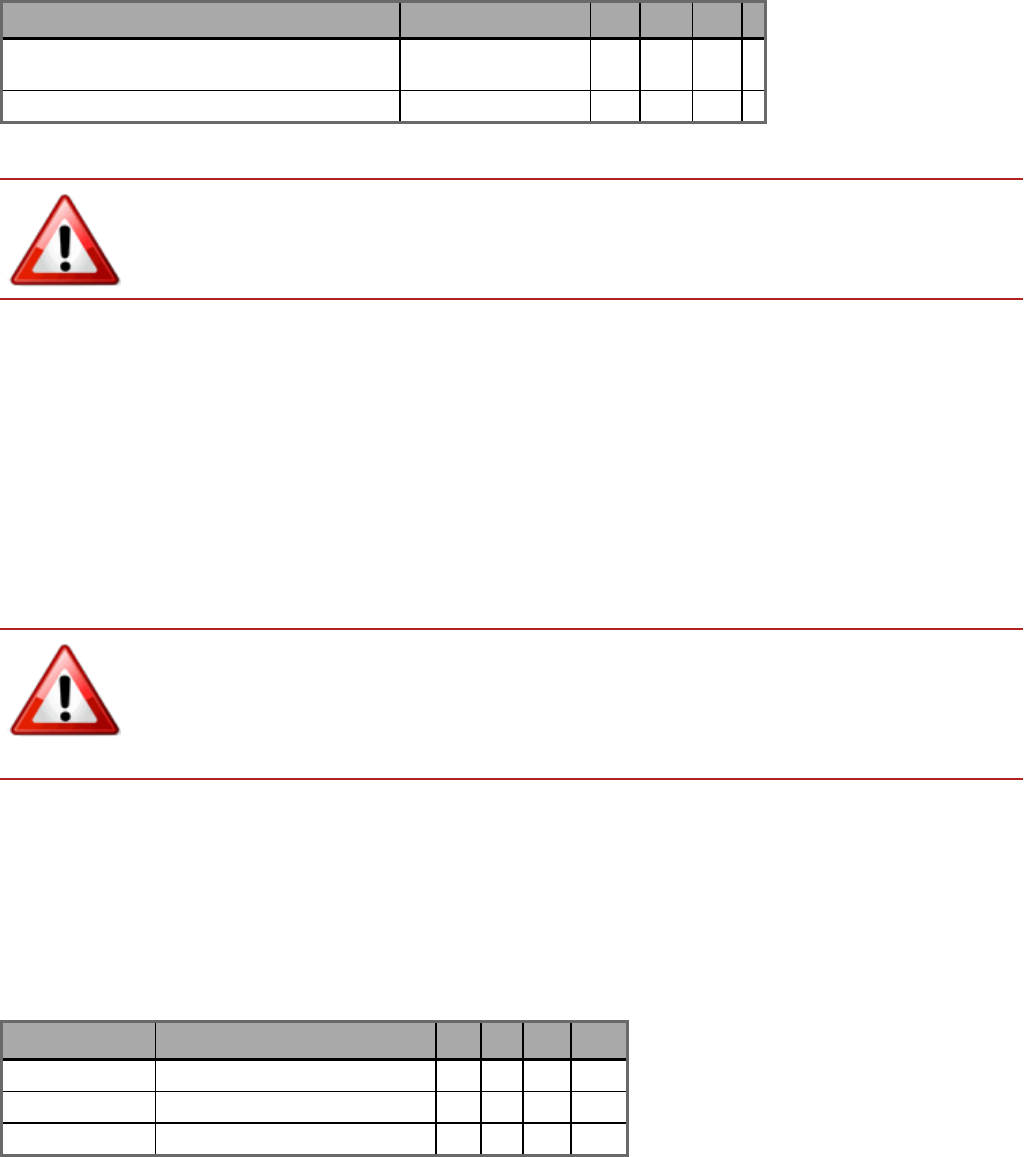
21 novatelwireless.com
Minimum ESD Protection Levels ESD/Input Voltage
Charge Device Model
EIA/JEDEC22-C101-A
500 V
RF Antenna IEC 61000-4-2 8000 V
As the integrator, it is your responsibility to protect the Enabler IIIG module from
electrical disturbances and excursions that exceed the specified operating
parameters.
Antenna
The GSM0308/GSM0306 module has one RF antenna connection on the module. The
connection is for the GSM section of the module.
Control Connector Signal Functions
Please note that we included the following descriptions to provide hardware-
level definitions. In some cases, specific lines will have no firmware functionality
implemented. We included information for each hardware-specific feature in the
appropriate section.
Module Power (Pins 85, 87, 89, 91, 93, 95, 97, 99)
The Novatel Wireless M2M Enabler IIIG module uses a single voltage source of VCC=+3.3V to
4.5V. (The exact values of the uplink currents are shown in the tables in section 5.3.1.)
VBAT Parameter/Conditions Min Typ Max Units
Main Battery Supply
Voltage In Regulation 3.3 4.5 Vdc
Peak Current 1000 mF on Host at Module Connector mA

22 novatelwireless.com
The uplink burst will cause strong ripple on the voltage lines and should be
effectively filtered. We recommend that you place 1000 to 2000 µF of
capacitance as close to the modem I/O connector as possible. Do not allow the
input voltage level to drop below the minimum voltage rating under any
circumstances, especially during the uplink burst period.
Power Control (Pin 35) - (PWR_CTL)
The input is equivalent to a “phone ON-button”. A falling-edge on this Active-Low input will
switch-ON the module or switch-OFF the module after a delay*. This input has a “weak pull-
up” resistor inside the module. You can leave this input grounded if it does not require the
RTC Sleep Function. If it requires RTC Sleep, then you must float the PWR_CTL line to allow
the internal resistor to pull the line high.
Only an open collector/open drain device may control the Power Control signal. Driving the
Power Control signal high may interfere with the normal operation of the modem. If driving
from an external microprocessor, you can control the Power Control by driving the control pin
low as an output, then changing the microprocessor’s pin control to be an input (this will
satisfy the high impedance requirement).
The AT$OFFDLY Command controls the OFF Delay. A value of 0 disables the
PWR_CTL line from turning the module off. 0 is the default value.
To enable the module to switch-OFF via PWR_CTL, you must set AT$OFFDLY to
a value other than 0. The valid range is 100 to 1000 milliseconds.
Turning On The Enabler IIIG
You must pull the PWR_CTL line on the Enabler IIIG LOW for at least 50mS (after applying
and stabilizing Vbat) to turn it ON. Allow a minimum of 2 seconds for Vbat to stabilize before
asserting the PWR_CTL signal to turn on the modem.
Do not use a pull-up resistor on the PWR_CTL line since the line is pulled up internal to the
modem.
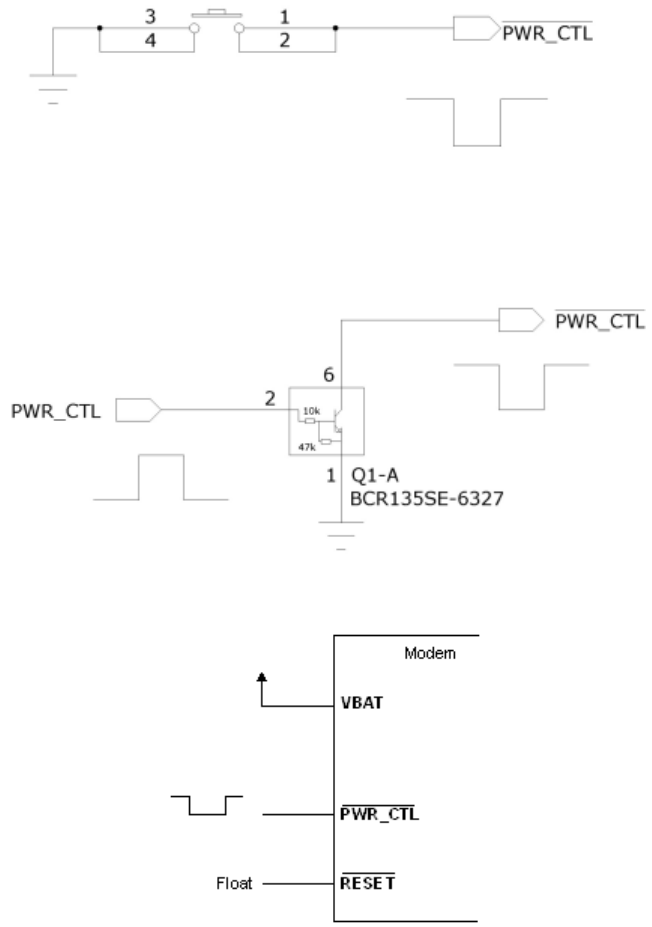
23 novatelwireless.com
Turning Off The Enabler IIIG
To turn the Enabler IIIG off, apply either a low pulse on the PWR_CTL line, or use a software
command (AT$OFF, see AT Command guide for further details).
Using The Power Control Signal
To power the module on/off with a switch:
Figure 3-8 Power Control Switch
To control the PWR_CTL from microcontroller:
To connect the PWR_CTL to modem:
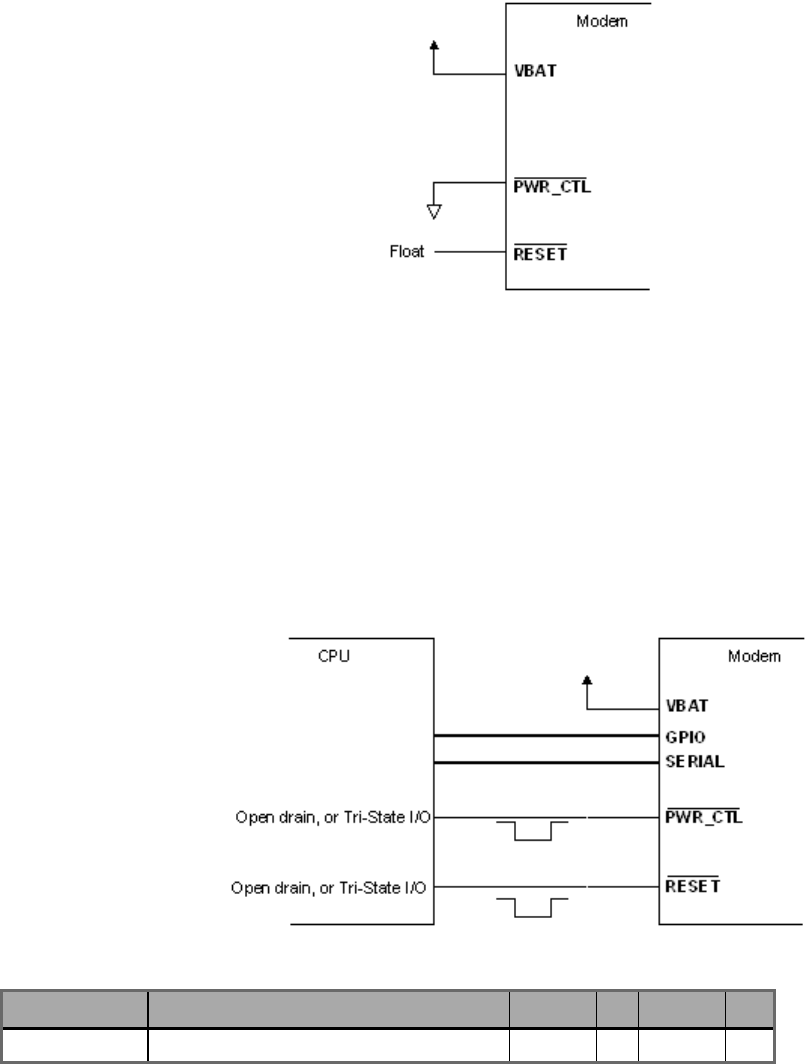
24 novatelwireless.com
External Power Control Signal (no external processor) shows a typical connection to the
Novatel Wireless M2M Enabler IIIG module in a machine-to-machine application using the
external PWR_CTL signal (when there is not an external processor controlling the power
on/off states). The RTC deep sleep functions will NOT function since the PWR_CTL pin is tied
low, the processor will never stay in a “RTC Sleep” mode. To reset the module, the power
(VBAT) must be cycled.
Figure 3-9 External Power Control Signal (no external processor)
The Power Control Signal (using external processor) figure shows a typical connection from an
external processor to the Novatel Wireless M2M Enabler IIIG module using the external PWR_
CTL signal. The Novatel Wireless M2M Enabler IIIG can be powered ON by using the PWR_
CTL signal. When using PWR_CTL, the I/O or serial lines can be at any voltage state desired.
We recommend that the I/O and serial lines be tri-stated or set low when the
GSM0308/GSM0306 is shutdown for an extended period of time to prevent any leakage
current from the processor to the modem.
Figure 3-10 Power Control Signal (using external processor)
Parameter Parameter/Conditions Min Typ Max Unit
VIL Input Voltage – Low or float 0.3 x VBAT Vdc
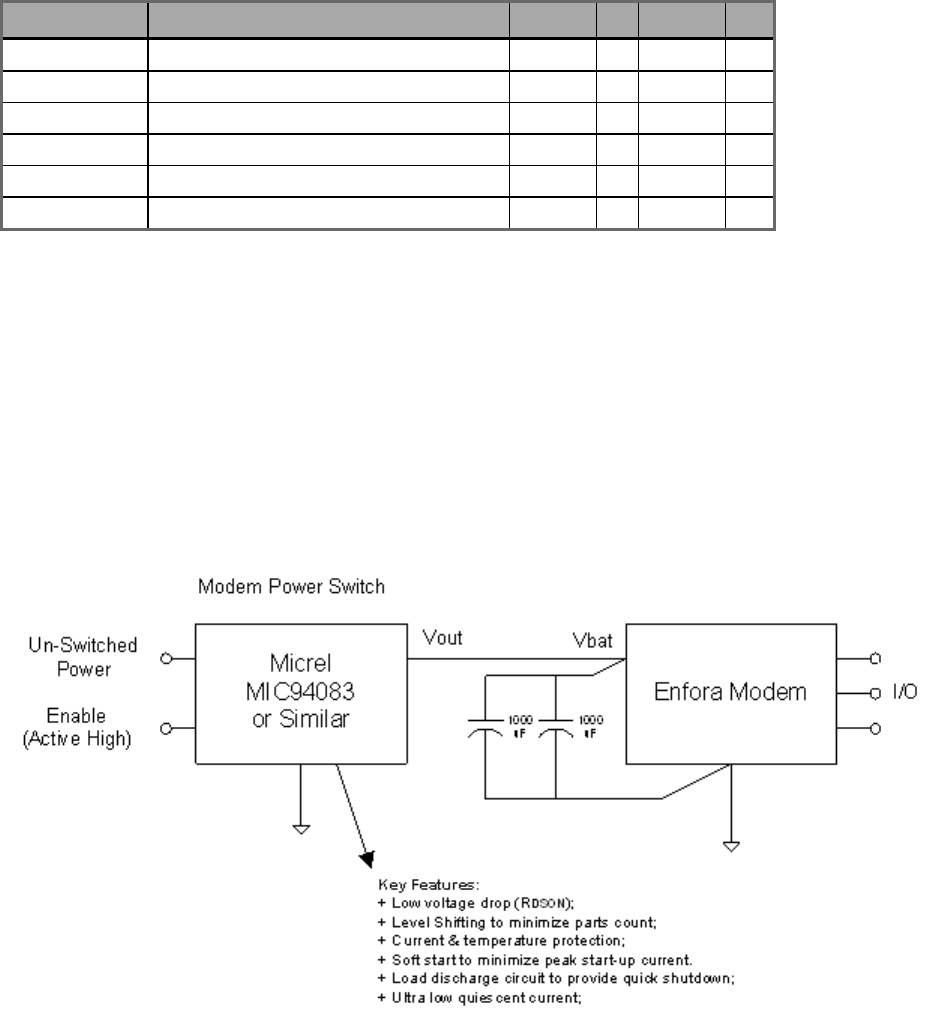
25 novatelwireless.com
Parameter Parameter/Conditions Min Typ Max Unit
VIH Input Voltage – High 0.7 x VBAT 1.95 Vdc
IPU Internal Pull-Up Resistor -40 -31 -15 mA
IIL Current sink -2.0 mA
ON Pulse Duration 10 50 mS
OFF Pulse Duration Minimum is programmable (AT$OFFDLY) 10 100 5000 mS
Boot time Time to boot from power on to command prompt 1.1 Sec
Modem Power Switch
If the modem does not respond to signals on the PWR_CTL line, a power cycle (OFF-ON) of
the modem’s power is required. This condition may occur due to unpredictable network
traffic and/or unstable power sources and is more likely when the modem is running 24 hours
a day, 7 days a week.
If the host assembly does not control power to the modem, you should add a power switch to
the host assembly similar to the one shown below.
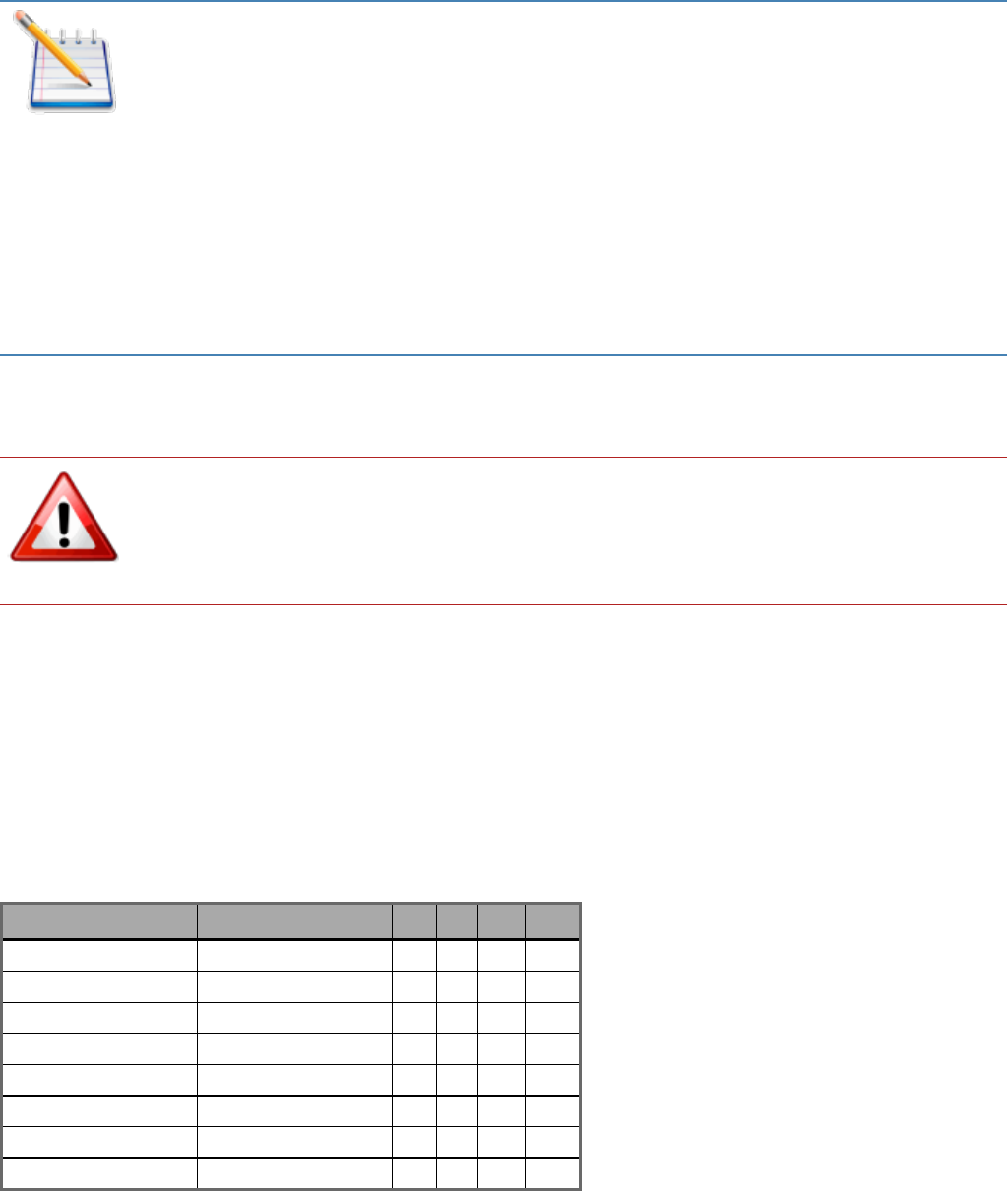
26 novatelwireless.com
If the modem's I/O lines have another source of power, the modem may not
completely shutdown/reset even with a mechanical power switch or with this
circuit implemented.
To alleviate this situation, make sure that the interface circuitry is set to tri-state
or as an input. If this is not possible, you may need additional hardware to shunt
high-impedance lines to ground during these situations.
The un-switched power source must be capable of supporting the inrush current
required by the bulk capacitance. The enable switch can be soft-started via
voltage ramp or modulation to reduce the peak current.
DO NOT USE a Modem Power Switch as a routine shutdown or reset. This
technique for shutting down the modem does not properly deregister the
modem from the network. The carrier may impose penalties if a fleet of
equipment does not follow a proper deregistration process.
Level Translation Reference Power (Pin 77)
Use pin 77 as a voltage reference source ONLY. Do not connect current loads to this pin. This
pin must be decoupled to ground with at least a 0.1 ?F capacitor at the output. Noise induced
on this pin will affect the performance of the baseband.
Low-Power Mode is entered when RTCWAKE is used to power down the modem with just
the RTC running.
VR I/O Parameter/Conditions Min Typ Max Units
Output voltage VOUT ON mode
LOW POWER mode 1.65
1.65 1.8
1.8 1.95
1.95 Vdc
Rated output current IOUT ON mode
LOW POWER mode 20
0.5 mA
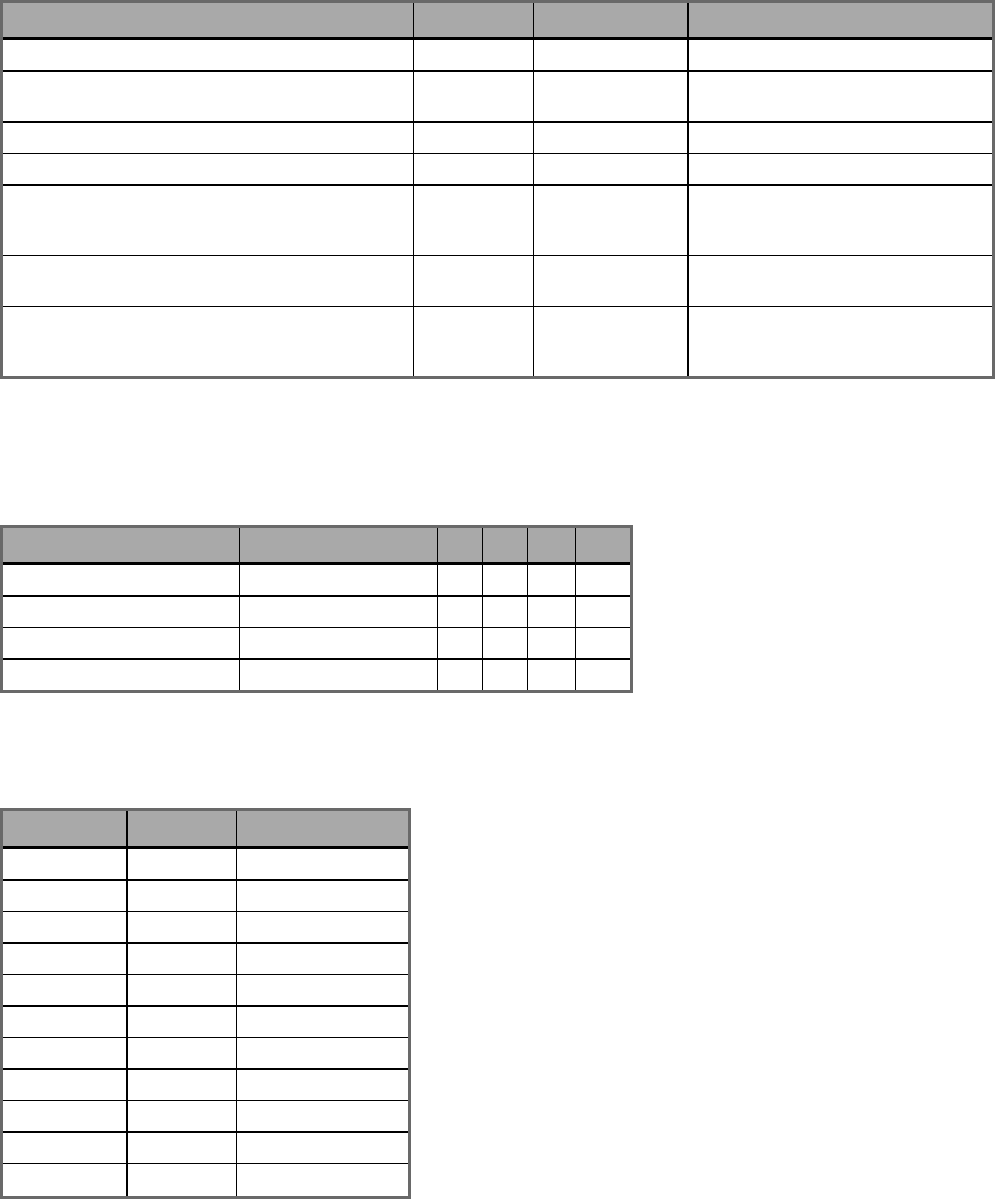
27 novatelwireless.com
USB (Pins 1, 3, 5, 7, 9)
Pin Name Pin Number Signal Direction Description
USB_VBUS 1, 3 In 5 V tolerant power Supply VBUS line;
Used only as a USB sense, not for powering the module.
(optional connection)
USB_DP 5 Analog I/O 5 V tolerant data plus pin in USB
USB_DM 7 Analog I/O 5 V tolerant data minus pin in USB
ID_USB 9 Analog I/O 5 V tolerant ID line, it defines the type of
device connected to the phone’s USB
port;
And also the default state (host / device) at the cable con-
nection;
The transceiver senses the voltage of this pin to determ-
ine if the pin is either floating (typical),grounded or res-
istively connected to ground (102 kW, 200 kW, 440 kW);
This is for Novatel Wireless M2M Debug only
5V Tolerant Transceiver
USB Parameter/Conditions Min Typ Max Units
Input Voltage 4.4 4.65 5.25 V
Output voltage High (Driven) 2.8 3.3 3.6 Vdc
Low 0.0 0.1 0.3 Vdc
Transceiver D+/- Leakage Current -2 2 μA
General Purpose Input/Output Interface
GPIO number Pin number Secondary Function
GPIO 1 64
GPIO 2 62
GPIO 3 60
GPIO 4 58
GPIO 5 68
GPIO 6 70
GPIO 7 66
GPIO 8 72
GPIO 9 14 MCSI_CLK
GPIO 10 16 MCSI_FSYNC
GPIO 11 18 MCSI_TX
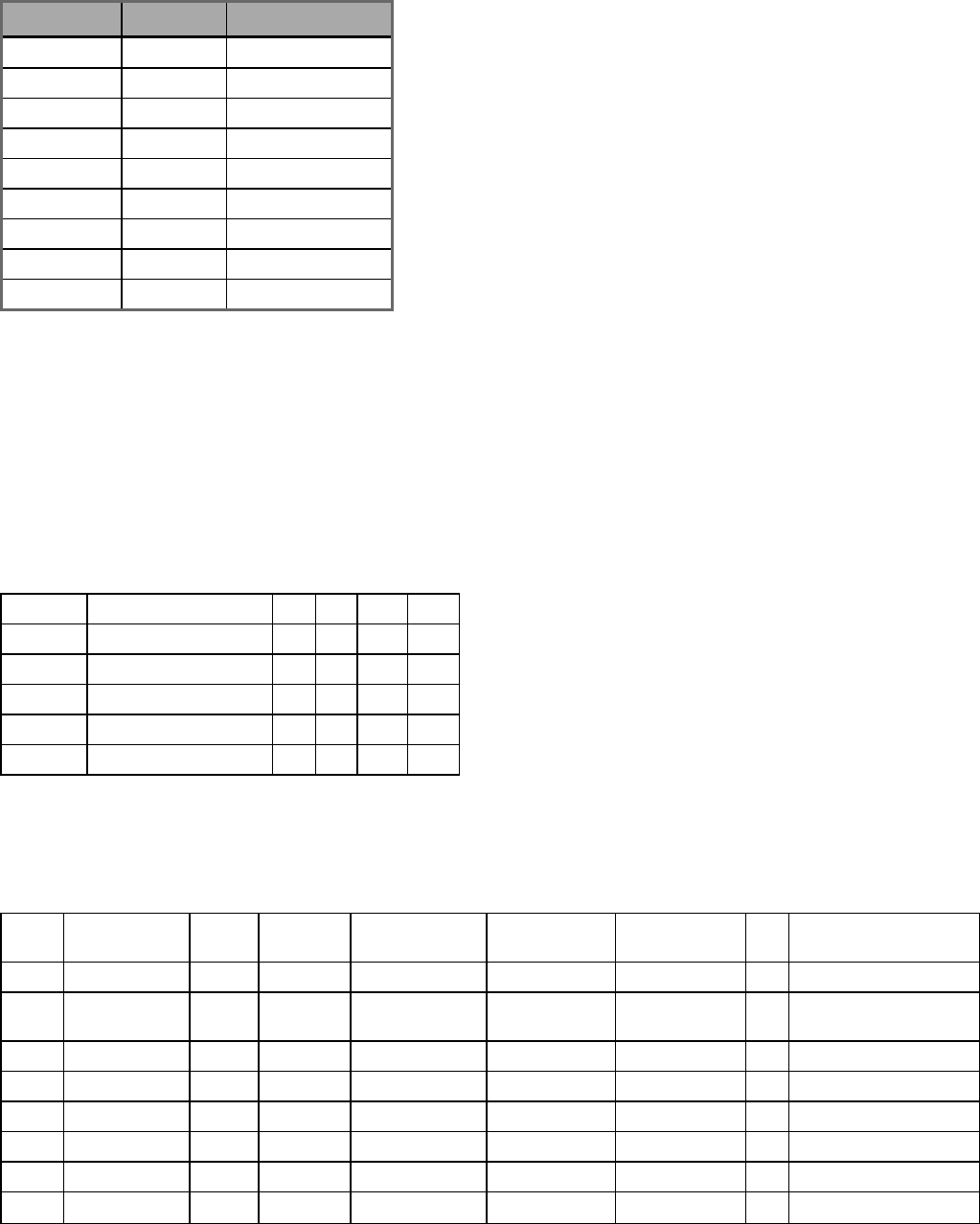
28 novatelwireless.com
GPIO number Pin number Secondary Function
GPIO 12 12 MCSI_RX
GPIO 13 30
GPIO 14 26
GPIO 15 22
GPIO 16 24
GPIO 17 28
GPIO 18 20
GPIO 19 34
GPIO 20 32
Each general-purpose signal may be selected as an input or an output. The GPIOs can be used
independently as a user-specified function, or may be used to provide modem control and
status signals. Several examples of modem control signals are: power shutdown command,
register/deregister on network command, and transmitter disable. Several examples of
modem status signals are: registration status and ready-for-power-down status to be used
with power shutdown command signal.
I/O Lines Parameter/Conditions Min Typ Max Units
VIL Input Voltage – Low 0 0.60 Vdc
VIH Input Voltage – High 1.11 1.8 Vdc
VOL Output Voltage – Low 0.45 Vdc
VOH Output Voltage – High 1.26 Vdc
IOL / IOH Rated Output Current 4 mA
The below table shows the factory default modem GPIO configuration:
I/O
No
PU/PD
Enabled
PU/DN I/O set-
ting
PU/PD cap-
ability
PU Value
KOhm
PD Value
KOhm
Iout Notes
1 1 PU IN PU/PD 18 90 4
2 X X IN - - 8 10k Pulldown on
Modem
3 1 PD IN PD - 18 8
4 1 PU IN PU/PD 18 90 4
5 1 PU IN PU/PD 18 90 8
6 1 PU IN PU/PD 18 90 4
7 1 PU IN PU/PD 18 90 4
8 1 PU IN PU/PD 18 90 8
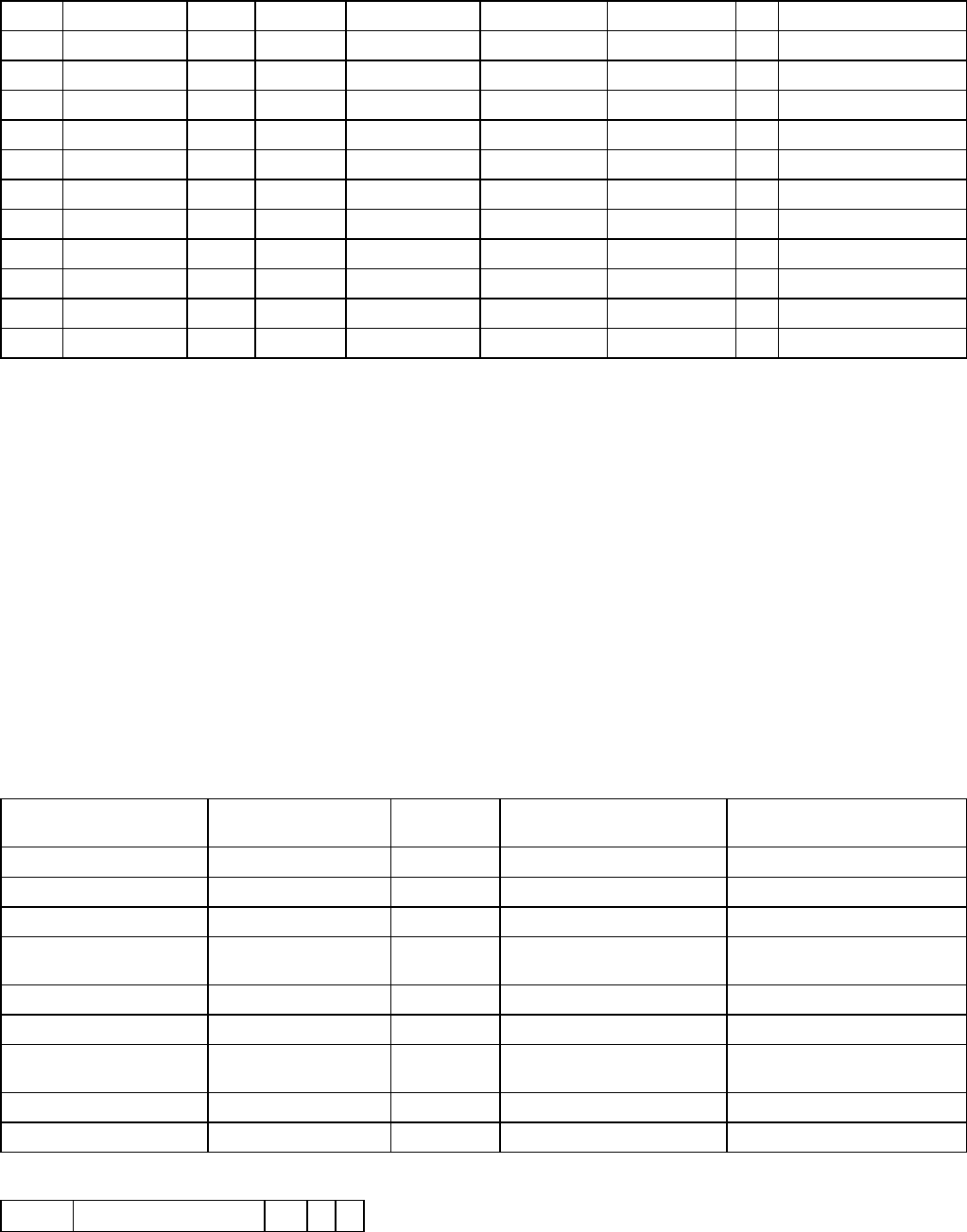
29 novatelwireless.com
9 1 PU IN PU 18 - 8
10 1 PU IN PU 18 - 8
11 1 PU IN PU 18 - 8
12 1 PU IN PU 18 - 8
13 1 PD IN PD - 18 8
14 1 PD IN PD - 18 8
15 1 PD IN PD - 18 8
16 1 PU IN PU/PD 90 90 8
17 1 PU IN PU/PD 90 90 8
18 1 PU IN PU 18 - 8
19 1 PU IN PU/PD 18 90 8
20 1 PU IN PU/PD 90 90 8
Factory Default Settings for I/O Pins, PU/PD Capability and Value of PU/PD Resistors.
RTC Sleep
In this mode, the modem is off except for its Real-Time-Clock. When put into this mode, the
modem can wake itself up at a designated time/interval. See Section 4.10 of the Enabler III AT
command manual for details
Serial Interfaces & Handshake (Pins 11, 13, 15, 17, 19, 21, 23, 25)
The pin naming for TX/RX/RTS/CTS/DTR/DSR is referenced as a DTE .The DTE device
should match their input pins to the Novatel Wireless M2M outputs and vice-versa.
Additionally, there are AT commands that may need to be executed in order to insure proper
operation. See the chart below.
9 way D Connector Pin
Number
Signal Signal Dir-
ection
Novatel Wireless M2M Pin
Number
Novatel Wireless M2M AT
Command
1 Carrier Detect (CD) from DCE 19 AT&C
2 Receive Data (RD) from DCE 15
3 Transmit Data (TD) from DTE 21
4 Data Terminal Ready
(DTR)
from DTE 17 AT&D
5 Signal Ground both
6 Data Set Ready (DSR) from DCE 25
7 Request To Send
(RTS)
from DTE 11 AT+IFC
8 Clear To Send (CTS) from DCE 13 AT+IFC
9 Ring Indicator (RI) from DCE 23
PU/PD
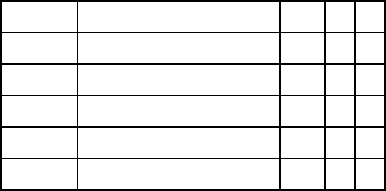
30 novatelwireless.com
Cap Used As Iout
(mA) PU
(Kohm) PD
(Kohm)
PU DCD output 4 18 -
PD External RING indicator 8 - 18
Factory Set Pin Configuration
The key features of the UART in the modem mode are as follows:
l 16C750 compatibility
l Baud rate from 300 bits/s up to 115200 Kbits/s, autobaud
l Configurable data format:
l Data bit: 5, 6, 7, or 8 bits
l Parity bit: even, odd, none
l Stop bit: 1, 1.5, 2 bit(s)
l Hardware flow control RTS/CTS
l Software flow control using XON/XOFF characters
The Enabler IIIG module is designed to be used like a DTE device.
Default settings are 8 data, 1 stop, no parity, and auto-baud. DTR may be used to force the
modem into AT command mode from online data mode (See AT Command Document,
command AT&D). RTS and CTS may be used for hardware handshaking. DSR is always active
(connected to ground) while the modem is on. RING may be used to alert the host to a variety
of incoming calls.
The serial interface is 1.8V logic. By default, hardware handshaking (AT+IFC) is enabled. The
module will be expecting the RTS line to be low before it will transmit data. If the integrator
does not wish to use flow control, please see below for minimal serial implementations:.
For a minimal Serial implementation use one of the following two configurations:
Configuration 1:
l Connect RxData (pin 15) and TxData (pin 21) to the COM port serial data lines.
l DTR (pin 17) and RTS (pin 11) be pulled up through a 100K resistor if not used.
l The user must set AT+IFC=0,0 to disable flow control to communicate with the modem.
Configuration 2:
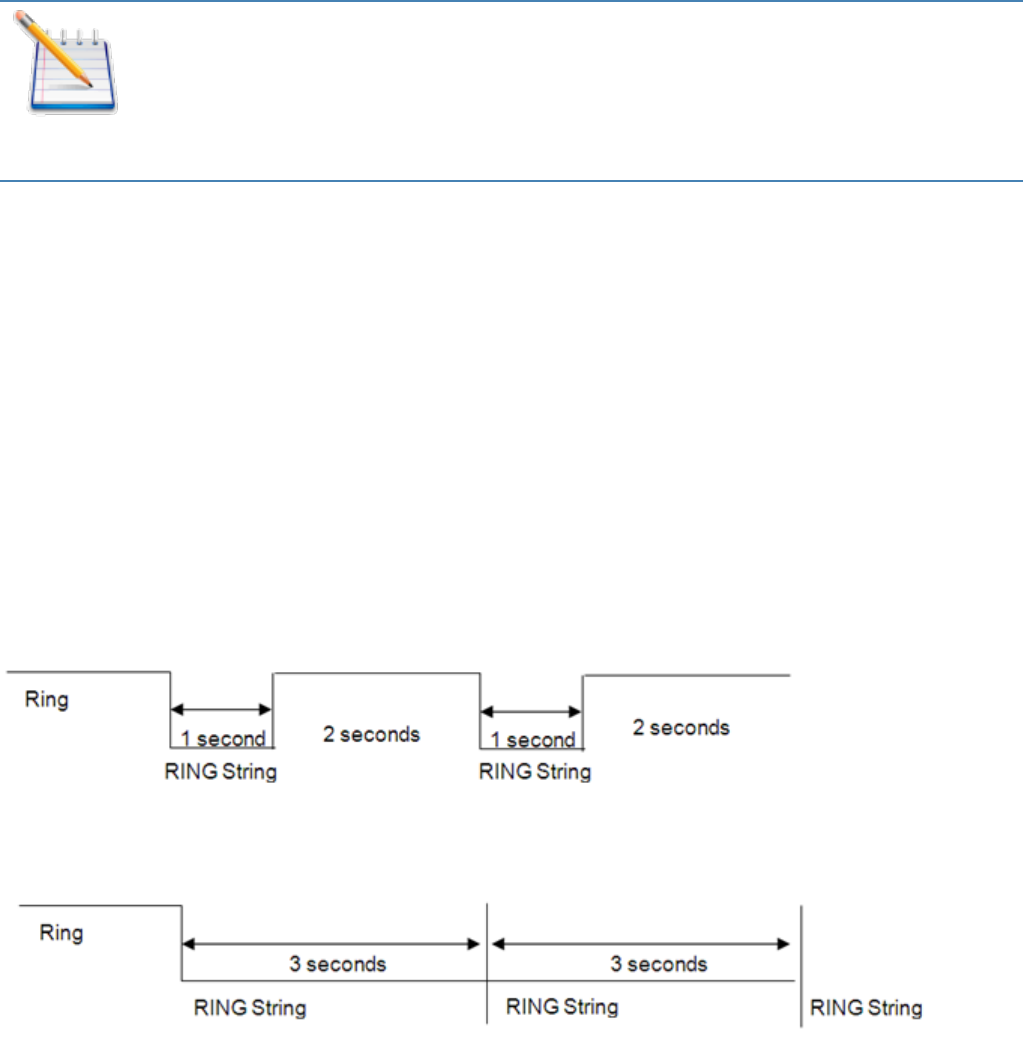
31 novatelwireless.com
l Connect RxData (pin 15) and TxData (pin 21) to the COM port serial data lines.
l Tie RTS (pin 11) to CTS (pin 13), and DTR (pin 17) to DSR (pin 25) on the modem to
loopback the flow control signals
l The user must set AT+IFC=0,0 to disable flow control to communicate with the modem.
Note:
It is not recommended tying DTR (pin 17) and RTS (pin 11) to ground to “spoof”
flow control. This will cause the modem to draw more current.
It is not recommended to leave that DTR (pin 17) and RTS (pin 11) unconnected.
If DTR (B12) is not connected, the default setting of AT&D0 must be maintained.
Ring Indicate (Pin 23)
The Enabler IIIG module is capable of using the Ring line to discern the type of incoming call.
The indicator can be monitored via a hardware line available on the 100-pin I/O signal
connector.
The function of the Ring line depends on the type of the call received.
When the module is receiving a voice call, the Ring line goes low for 1 second and high for
another 2 seconds. Every 3 seconds the ring string is generated and sent over the Receive
(Data Out) (Rx) line. If there is a call in progress and call waiting is activated for a connected
handset or hands free device, the Ring pin switches to ground in order to generate acoustic
signals that indicate the waiting call.
When a Fax or data call is received, Ring goes low and will remain low. Every 3 seconds a ring
string is generated and sent over the Receive (Data Out) (Rx) line.
When an incoming SMS is received, Ring indicate goes low for 1 second, then returns to a high
state. See below logic diagram.
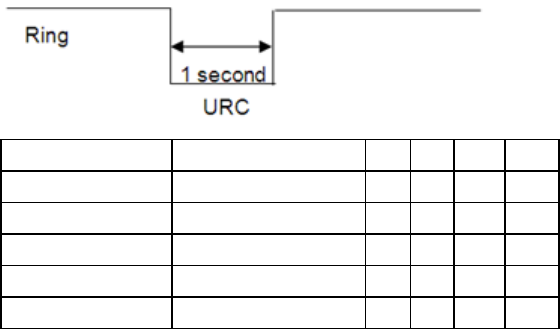
32 novatelwireless.com
Serial I/O & Control Parameter/Conditions Min Typ Max Units
VIL Input Voltage – Low 0.54 Vdc
VIH Input Voltage – High 1.26 1.95 Vdc
VOL Output Voltage – Low 0.54 Vdc
VOH Output Voltage – High 1.26 1.95 Vdc
IOL / IOH Rated Output Current 2.0 mA
Multi-Channel Serial Interface (MCSI) – (Pins 12, 14, 16, 18)
This port is only available in Master mode and to be used for PCM digital audio. Below are the
settings for configuring it operation and the interface specification:
Digital Audio Configuration
The default settings for the digital audio are:
l Mode = Master
l MCSI_CLK = 520KHz
l Word Size = 16 Bits
l Sync Pulse = 8KHz
l Frame mode = burst
l Clock edge Sync = rising edge
Configuring the MCSI for Digital Audio
The following two commands are required to set the unit up in digital audio mode:
AT$voicepth=2
This configures the EIII module to use digital audio instead of analog audio.
at$ioblks=0,1
This configures the I/O pins of the module to be used as the secondary function which is the
MCSI port. It automatically configures the direction of the pins.
Do not alter the settings for these 4 pins manually (direction, pull up or alternate
configuration) as this will stop the MCSI port working for digital audio.
Data Format
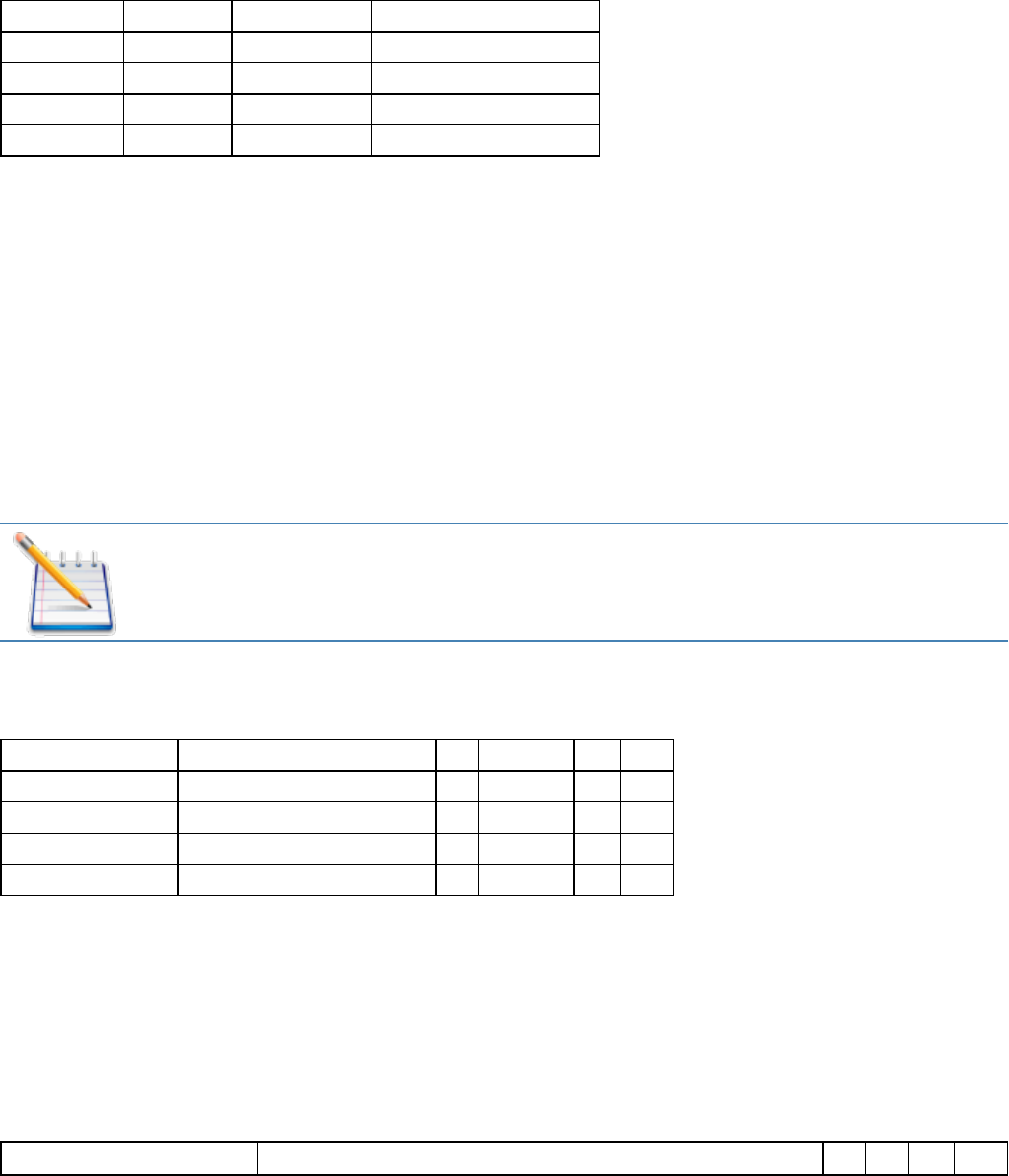
33 novatelwireless.com
The 16 bit word is sent MSB first. Data received is also MSB first. No other data manipulation is
done within the module.
Pin Name Pin Number Signal Direction Description
MCSI_RX 12 I Serial Data Input
MCSI_TX 18 O Serial Data Output
MCSI_CLK 14 IO Serial Clock I/O
MCSI_FSYNC 16 IO Frame Synchronization I/O
VBackup Input (Pin83)
The backup battery can be recharged from the main battery. A programmable voltage
regulator powered by the main battery allows recharging the backup battery. The backup
battery charge starts when the following conditions are met:
Backup battery charge is enabled by a control bit:
l Main Battery voltage > Backup Battery voltage
l Main battery > 2.8 Vdc
Note: If the backup battery is not present, the backup battery pin is connected to
main battery pin
VBACKUP is a power input for the Real-Time-Clock when using RTC-Sleep Function
VBACKUP Parameter/Conditions Min Typ Max Units
Input Voltage Range ON mode 2.5 VCC1 5.5 Vdc
BACKUP mode, VBAT=0v 1.9 VBACKUP 5.5
BACKUP mode, VBACKUP=0v 1.9 VCC2 3.0
Input Current 10 mA
Using VBackup
VBACKUP is a backup voltage that can maintain the RTC clock and alarm functions. If
VBACKUP is not present in the system (intentionally or not) the RTC clock may still be
powered if leakage voltage exists on VCC. Otherwise, the RTC clock will lose power and be
reset when VCC is restored.
PARAMETER Parameter/Conditions Min Typ Max Units
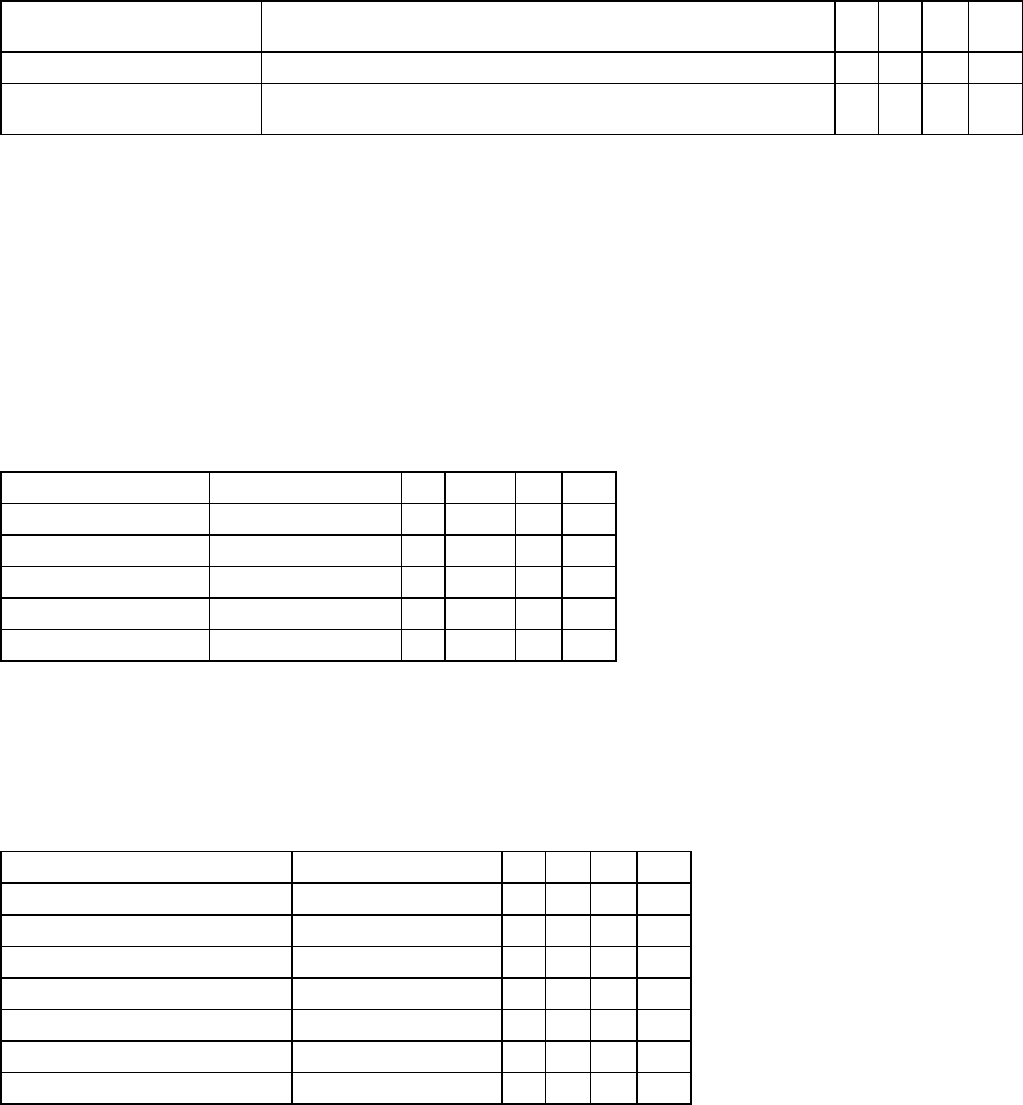
34 novatelwireless.com
Backup Voltage (Real-Time-
Clock)
VBACKUP Backup Voltage for Real-Time-Clock 2.7 3.0 4.5 Vdc
IBACKUP Input Current (VBACKUP = 3.2 V, VBAT = 0 V, No Load on GPIO or
Serial Port)
3.0 6.0 mAdc
VBACKUP had been tested in the above scenarios and does not contribute to leakage. It will
properly provide backup power to the RTC clock.
KHZ Output (Pin 56)
A 32.768 kHz signal is available as an output from the module. This signal should only be used
as an input to a high impedance device. Additional loads or capacitance on the line may cause
performance issues with the module. If the line is not used, leave floating.
32kHz Clock-Out Parameter/Conditions Min Typ Max Units
VIH Vdc
VIL Vdc
Maximum capacitor load tbd pF
Maximum resistive load W
Frequency ± 30 ppm 32.768 kHz
Analog-to-Digital Input (Pin 74)
The monitoring ADC (MADC) consists of a successive approximation 10–bit analog–to–digital
converter (ADC).
Analog-To-Digital Input Parameter/Conditions Min Typ Max Units
ADCBRES ADC Binary Resolution 10 Bits
ADCREF ADC Reference Voltage 1.75 Vdc
VADC ADC Range 0 1.75 Vdc
Integral/Differential Non-Linearity -2 2 LSB
Input Leakage tbd mA
Retuning Frequency 1 MHz
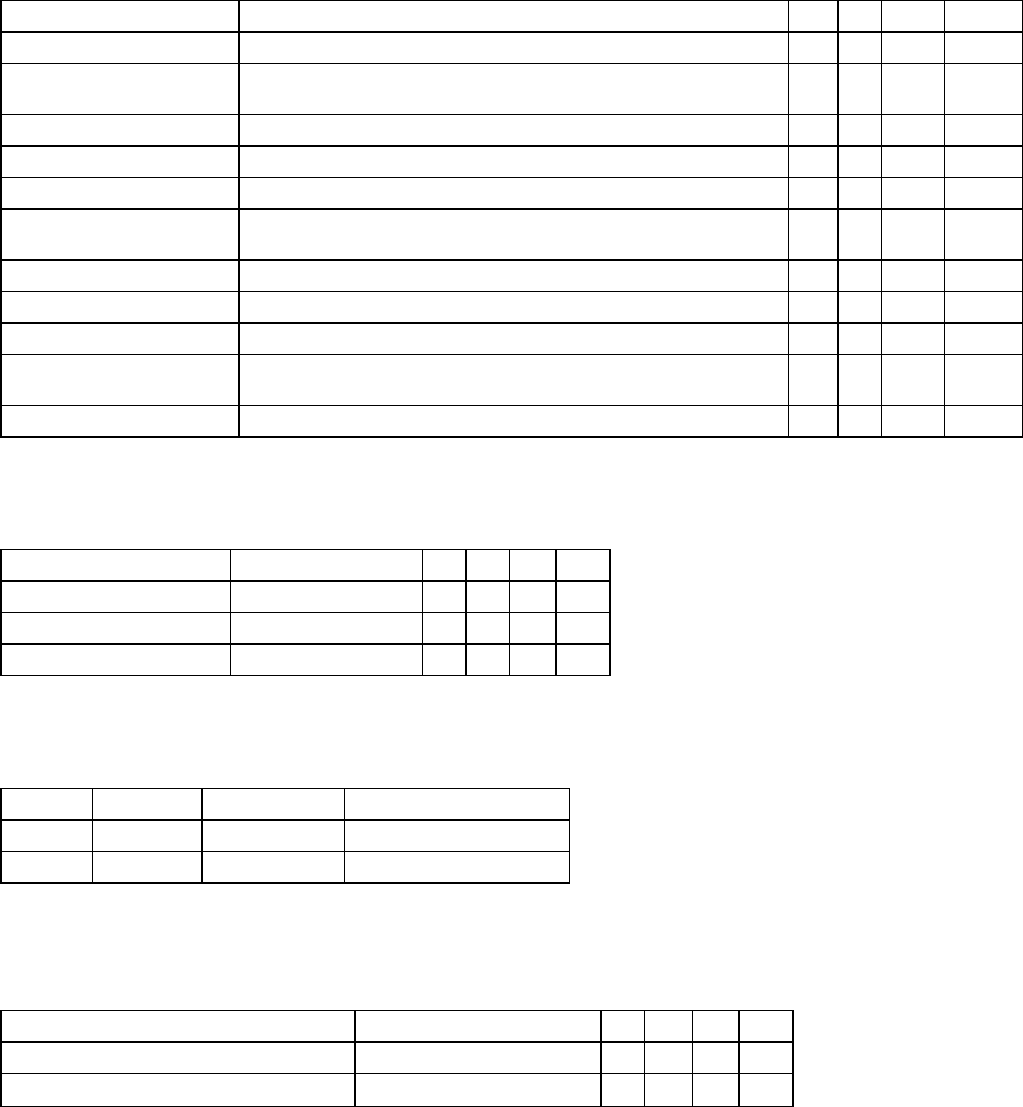
35 novatelwireless.com
Handset Microphone Input (Pins 65, 67)
The handset differential inputs MICIP and MICIN can be amplified by the differential handset
microphone amplifier. This amplifier has a gain of 25.6 dB and a bias generator MICBIAS
provides an external voltage of 2 V or 2.5 V to bias the microphone.
Handset Mic Input Parameter/Conditions Min Typ Max Units
Maximum Input Range –
Mic(+) to Mic(-) Inputs 3 dBm0 (Max. digital sample amplitude when PGA gain set
to 0 dB)
32.5 mVRMS
Nominal Ref. Level –
Mic(+) to Mic(-) Differential MIC
-10 dBm0
Differential Input Resist-
ance –
Mic(+) to Mic(-) Differential MIC, MICAMP gain = 25.6 dB
(INMODE = 0001)
36 kW
Microphone Pre-Amplifier
Gain
Differential MIC
25.6 dB
Handset Microphone Bias Output (Pin 63)
Mic Bias Output Parameter/Conditions Min Typ Max Units
Bias Voltage on Mic(+) Set to 2.0 V 1.9 2.1 Vdc
Set to 2.5 V 2.4 2.6 Vdc
Mic Bias Current Capability 2.0 mA
Handset Speaker Output (Pins 71, 73)
Pin Name Pin Number Signal Direction Description
EARP 71 O Earphone positive output
EARN 73 O Earphone negative output
The earphone amplifier provides a full differential signal on the terminals EARP and EARN
(Earphone).
Handset Spkr Output Parameter/Conditions Min Typ Max Units
Maximum Differential Resistive Load Output Swing 3.9 VPP 120 W
Output Swing 1.5 VPP 33 W
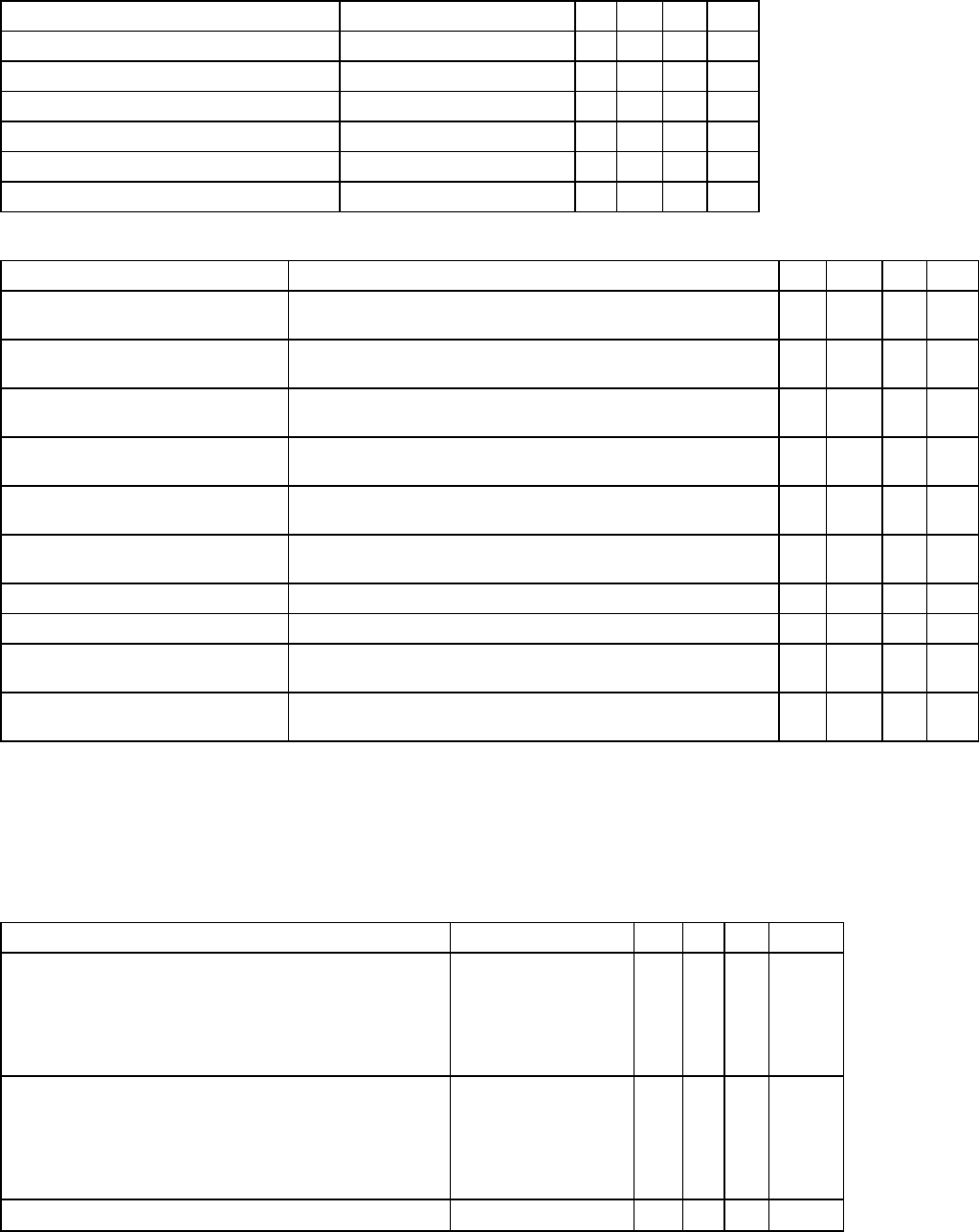
36 novatelwireless.com
Maximum Differential Capacitive Load 100 pF
Common Mode Minimum Resistive Load At Internal Speaker (+) or (-) 200 kW
Common Mode Maximum Capacitive Load At Internal Speaker (+) or (-) 50 pF
Amplifier Gain EARG = 1
EARG = 0 1
-11 DB
dB
Parameter Test Conditions Min Typ Max Units
Earphone output swing at EARP-
EARN
Distortion ≤ 2% and 120 Ω, VSP input level = +3 dBm0, amp
gain = -11 dB
0.98 VP-P
Distortion ≤ 2% and 33 Ω, VSP input level = -5.34 dBm0, amp
gain = -11 dB
0.38
Distortion ≤ 2% and 120 Ω, I2S input level = +3 dBm0, amp
gain = -11 dB
0.93
Distortion ≤ 2% and 120 Ω, VSP input level = +3 dBm0, amp
gain = 1 dB
3.1 3.92
Distortion ≤ 2% and 33 Ω, VSP input level = -5.34 dBm0, amp
gain = 1 dB
1.2 1.5
Distortion ≤ 2% and 120 Ω, I2S input level = +3 dBm0, amp
gain = 1 dB
2.96 3.7
Earphone amplifier gain EARG = 1 1 dB
EARG = 0 -11 dB
Earphone amplifier state in power
down
High
Z
Earphone amplifier power supply
rejection
1 kHz, 100 mVp-p 50 dB
An external audio amplifier should be used for loads of less than 16 W or if volume is
inadequate.
Headset Microphone Input (Pin 55)
Mic Input Parameter/Conditions Min Typ Max Units
The headset differential inputs HSMIC and AUXI can be
amplified by the differential handset microphone amp-
lifier. This amplifier has two different gains 4.9 dB or
25.6 dB and a bias generator HSMICBIAS provides an
external voltage of 2 V or 2.5 V to bias the microphone.
Headset Mic Input
Maximum Input Range Inputs 3 dBm0 (Max-
imum digital sample
amplitude with PGA
gain set to 0 dB),
AUXAMP gain = 18
dB, Single HSMIC
78 mVRMS
Nominal Ref. Level -10 dBm0
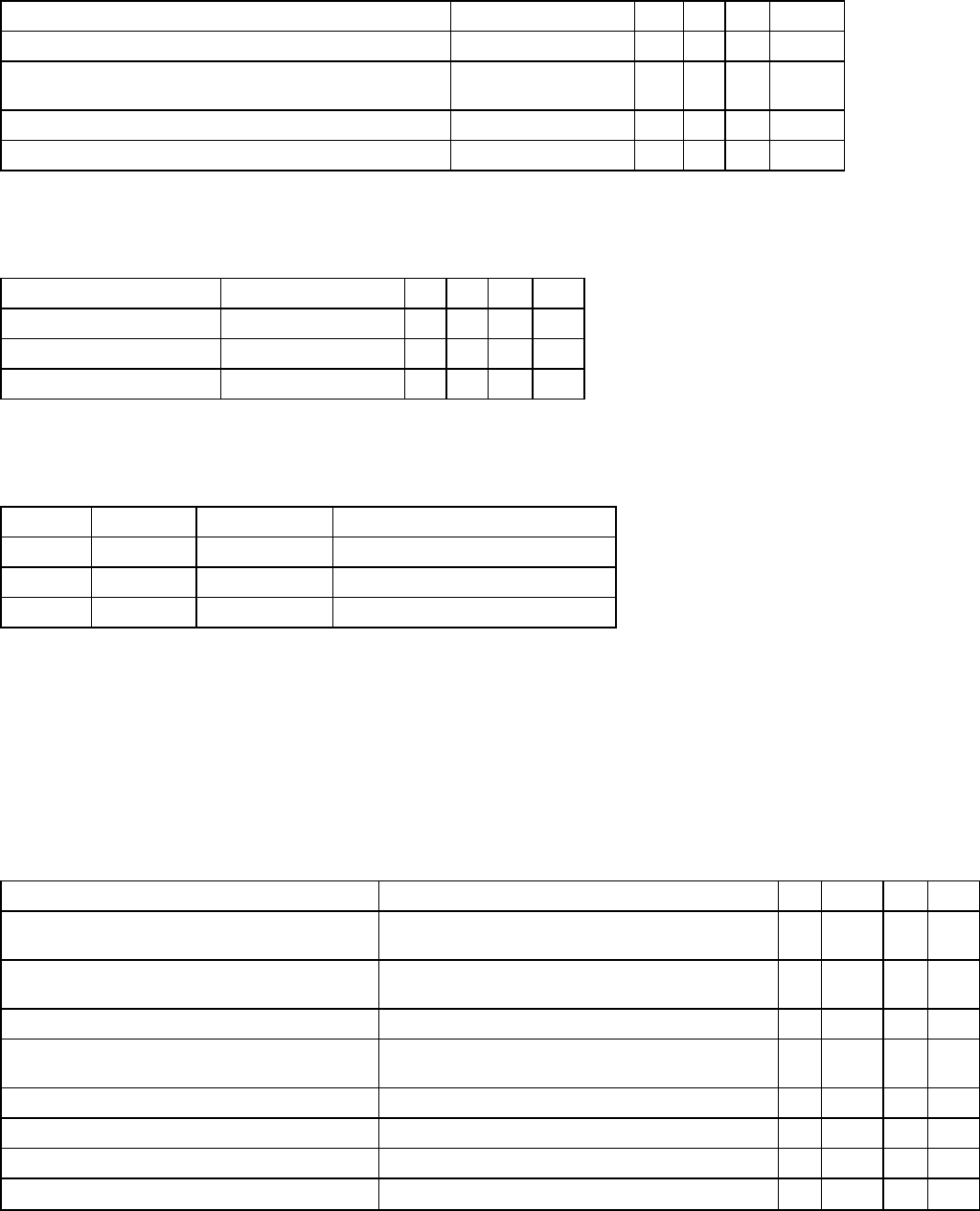
37 novatelwireless.com
Microphone Pre-Amplifier Gain 18 dB
Input resistance at HSMIC
HSMIC single input,
AUXAMP
gain = 18 dB
40.5 kΩ
Headset Microphone Bias Output (Pin 53)
Mic Bias Output Parameter/Conditions Min Typ Max Units
Bias Voltage on Mic(+) Set to 2.0 V 1.9 2.1 Vdc
Set to 2.5 V 2.4 2.6 Vdc
Mic Bias Current Capability 2.0 mA
Headset Speaker Output Left & Right (Pins 57, 59)
Pin Name Pin Number Signal Direction Description
HSOL 57 O Headset Out 32W Speaker Left
HSOR 59 O Headset Out 32W Speaker Right
HSOVMID 61 I Headset Out pseudo ground return
The left and right headset amplifiers provide the stereo signal on terminals HSOL and HSOR.
A pseudo ground is provided on terminal HSOVMID to eliminate external capacitors. The
mono audio signal can be provided on the Right or the Right and Left headset outputs.
HSOVMID is available to allow integrators to supply a bias or DC offset to increase the
dynamic range of the Headset.
Headset Spkr Output Parameter/Conditions Min Typ Max Units
Maximum Swing Distortion £ 2% and 32 W, VSP input level = +3
dBm0
1.6 1.96 VP-P
Distortion £ 2% and 32 W, I2S input level = +3
dBm0
1.48 1.85
Maximum Capacitive Load 100 pF
Minimum resistive load at HSOL and HSOR:
Zload
32 W
Amplifier Gain -5 dB
HSOL/R amplifier Power supply rejection
1 kHz, 100 mVpp
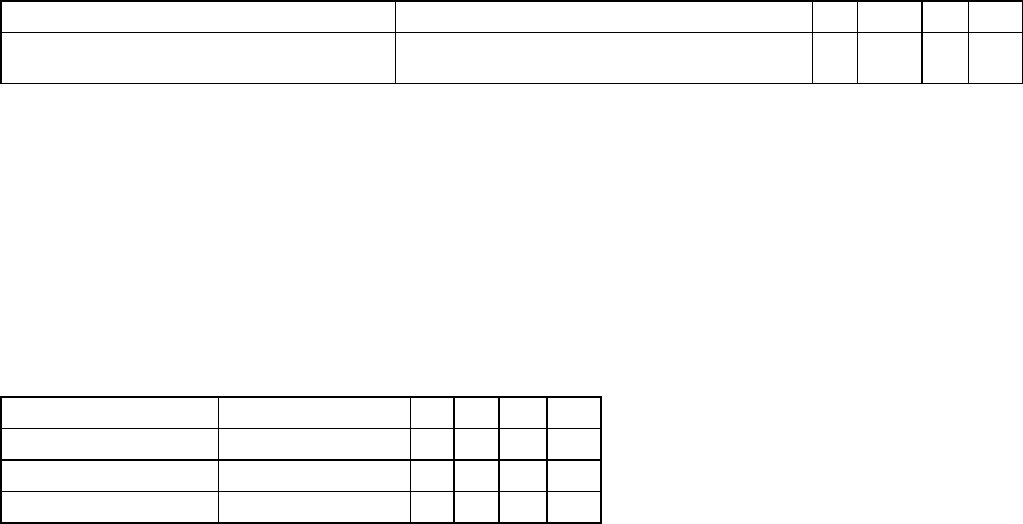
38 novatelwireless.com
50 dB
Amplifier State in Power Down High
Z
The left and right channels of the headset speaker output are a single ended output. An
external audio amplifier should be used for loads of less than 32 W or if volume is inadequate.
Headset Output Common Mode (Pin 61)
The left and right headset amplifiers provide the stereo signal on terminals HSOL and HSOR.
A pseudo ground is provided on terminal HSOVMID to eliminate external capacitors.
HSOVMID Parameter/Conditions Min Typ Max Units
Maximum Capacitor Load 200 pF
DC Level 1.2 1.35 1.5 V
Headset Detect (Pin 47)
Headset Plug/Unplug detection. This pin is used to automatically switch to the headset audio
path when enabled with AT$VSELECT=3. The device will default to handset when no
Headset is detected.
2 modes:
l Module already ON (Battery connected, VRIO ON) and plug event;
l Module OFF and plug event: the plug detection will be effective once VRIO is set ON
Plug and unplug detections are digitally debounced (debouncing time = 8 ms).
The jack plug detection feature is addressed through the HSDET pin. The integrated pull up,
connected to the pin, forces a high level (VBAT) when the headset load is not connected. At
jack insertion headset load connection (32 W) imposes a low level on that node (Headset left
channel): as an example HSDET = 1 mV after jack plug for VBAT = 4 V.
Input comparator threshold voltages are defined as VTlow = VBAT/2 – 100 mV and VThigh =
VBAT/2 + 100 mV, VBATmin = 3.2 V. The plug and unplug detection remains functional if
there is no signal from HSOL amplifier output (stereo path is OFF) or if there is a signal from
HSOL (stereo path is ON): maximum level on HSOL when the stereo path is ON is 1 Vp-p which
stays far enough from the comparator threshold levels VBATmin/2 – 100 mV and VBATmin/2
+ 100 mV.
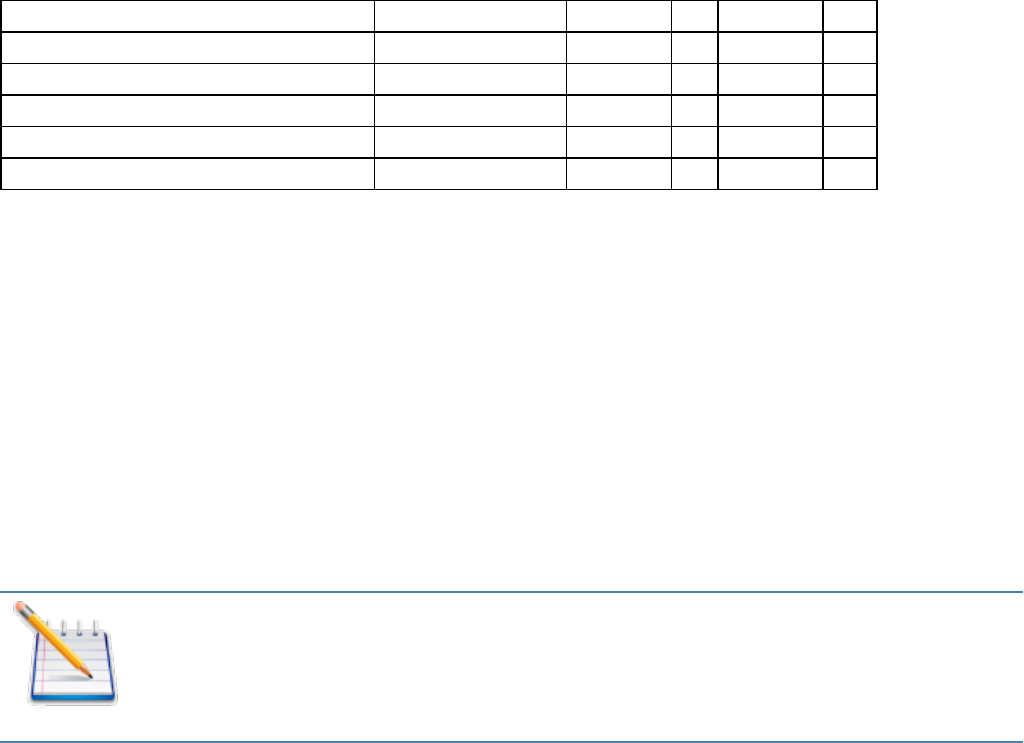
39 novatelwireless.com
Jack plug detection is functional if a plug event occurs before the power up of the module or
if the plug event occurs after the power up of the module: analog detection part is always
active if the battery is connected. Detection interrupts will be generated once the VRIO
regulator is power up during the module power up sequence.
A level change on HSDET pin is sensed by a Schmitt trigger to provide a jack detection signal
to the audio digital control. The audio digital control receives the detection signal and
proceeds to a digital debouncing (time: 8 ms = 256 * 32 kHz clock periods) before sensing that
a plug event happened on the jack connector.
Headset Detect Parameter/Conditions MIN TYP MAX UNIT
Low level input voltage VIL related to VBAT
0.3 * VBAT V
High level input voltage VIH related to VBAT
0.7 * VBAT V
Current with pull-up -40 -31 -15 μA
Subscriber Identity Module (SIM) Carrier (Pins 76,
78, 80, 82, 84)
The SIM, an integral part of any GSM terminal device, is a “smart card” that is programmed
with subscriber information:
l The user information consists of an International Mobile Subscriber Identity (IMSI)
number, which is registered with the GSM provider, and an encryption Ki (pronounced
"key"). This information consists of a microprocessor and memory installed on a plastic
card.
Note: The SIM is not provided with the Novatel Wireless M2M Enabler IIIG
module. The SIM must be obtained from the GSM service provider and must be
provisioned by the operator for data and/or voice. Always take care to protect
the SIM: the GSM terminal will not operate without the SIM installed.
The SIM provides the IMSI for authentication. To gain access to the GSM network, the network
must recognize the IMSI number, and the terminal must be able to properly decrypt the data
sent by the network. The SIM also serves as a buffer for SMS messages, storing the message
for transmission until a radio link is available and buffering received messages until retrieved.
40 novatelwireless.com
SIM INTEGRATION FOR THE Novatel Wireless M2M ENABLER IIIG MODULE
The Enabler IIIG module default configuration does not include an on-board SIM carrier.
Novatel Wireless M2M provides a separate product SKU for the Enabler IIIG module with the
integrated SIM carrier.
Using A Remote SIM With The Novatel Wireless M2M Enabler
IIIG Module (PINS 76, 78, 80, 82, 84)
The Enabler IIIG module default configuration does not include an on-board SIM carrier.
The module supports the use of 1.8 V and 3 V SIM cards. The module includes a hardware
interface module dedicated to Universal Subscriber Identity Module (USIM). All baud-rates
defined in ISO 7816-3 standard are supported for high-speed transmission.
The module optionally includes an on-board SIM carrier. All other modules require a remote
SIM carrier/connector. If the module is going to be integrated using a remote SIM, the
following guidelines are provided:
l To utilize a remote SIM, the integrator must provide a suitable SIM connector.
l The maximum distance from the module to the remote SIM connector must not exceed
25.4 cm (10 inches).
l It is recommended to have Zero resistance between the SIM connector and the module.
l External ESD Protection is Required;
l 15 kV Air Discharge;
l 8 kV Contact Discharge;
The transorb must have a low junction capacitance (typically < 10 pf) such as the following
part:
Novatel Wireless M2M PN: TRS-0000-5009
Manufacturer: On Semi
Manufacturer PN: NSQA6V8AW5T2G
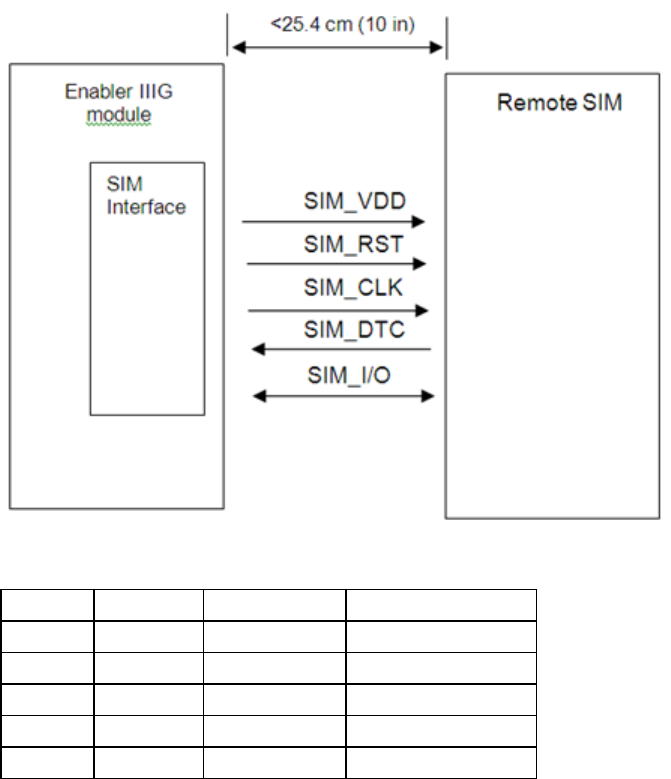
41 novatelwireless.com
Figure 3-11 Remote SIM Interface
Pin Name Pin Number Signal Direction Description
SIM_VDD 76 O SIM VDD
SIM_CLK 78 O Card Reference Clock
SIM_RST 80 O Card Reset
SIM_I/O 82 I/O Card I/O Data
SIMDTC 84 I Card detect
The module provides the regulated supply voltage for the SIM-card and the circuitry to
detect the insertion or extraction of the SIM-Card in or from the mobile.
The SIMDTC is disabled by default (see AT$SIMDTC in the EIII AT Command Manual for
settings). When enabled, the SIMDTC pin has an internal pull up to Vcc and can be configured
to detect a SIM insertion when the SIMDTC is either pulled to ground or left floating.
It can configured to detect either just a SIM removal or both removal and insertion. SIM
detection is also dependent on the setting of the AT$AREG and AT+CFUN commands (see
AT$SIMDTC in the EIII AT Command Manual for more information).
When the module detects a SIM removal, it will de-register from the network. When the
module is configured to and detects a SIM insertion, it will re-register the module on the
network.
The SIM-card presence detection logic is active even when the system is in idle mode.
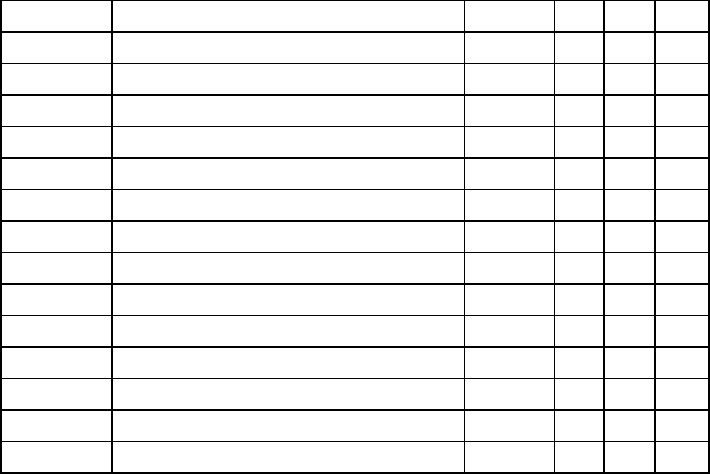
42 novatelwireless.com
USIM Parameter/Conditions Min Typ Max Units
VDD SIM VDD voltage 1.65 1.8 1.95 V
2.7 2.85 2.95 V
VIH High level input voltage 1.15 V
VIL Low level input voltage 0.61 V
VOH High level output voltage, IO = 4 mA Vdd-0.45 V
VOL Low level output voltage, IO = 1 mA 0.4 V
II Input leakage current ±1 μA
Iout Output current 4 mA
PU PU resistance 32 kΩ
PD PD resistance 30 kΩ
Iz Leakage current ± 30 μA
Card Detect Debouncing time (SIM-card insertion) 0.5 mS
Debouncing time (SIM-card extraction) 15 mS
Pull-up resistor (resistor + resistive switch) 475 kΩ
Remote SIM Component Information
Any compatible SIM carrier can be used in conjunction with the Enabler IIIG module. For
example:
Lumberg P/N 8840_A_21.
or Suyin P/N: 254016MA006G103ZL
Remote SIM Example
ESD protection is required for all SIM sockets. A Transient Voltage Suppressor (TVS) diode
with low capacitance, typically less than 10pF, should be used. ESD protection is required for
PTCRB and GCF approval and should be located as close to the connector as possible. Signal
lines from the connector to the modem should be routed 'through' the pad of the diode,
rather than a 'T' branch. Decoupling capacitance on SIM_VDD will be required, and should be
placed as close to the SIM connector as possible. The value of the required capacitor will vary
by design, and will typically be below 0.1uF. The SIM electrical tests will be conducted during
the PTCRB and GCF approval process. Experimentation of the capacitance value may be
required to pass these tests. Factors affecting the capacitance of the SIM_VDD line include:
trace length, capacitance of the TVS diode, and physical placement of the capacitor.
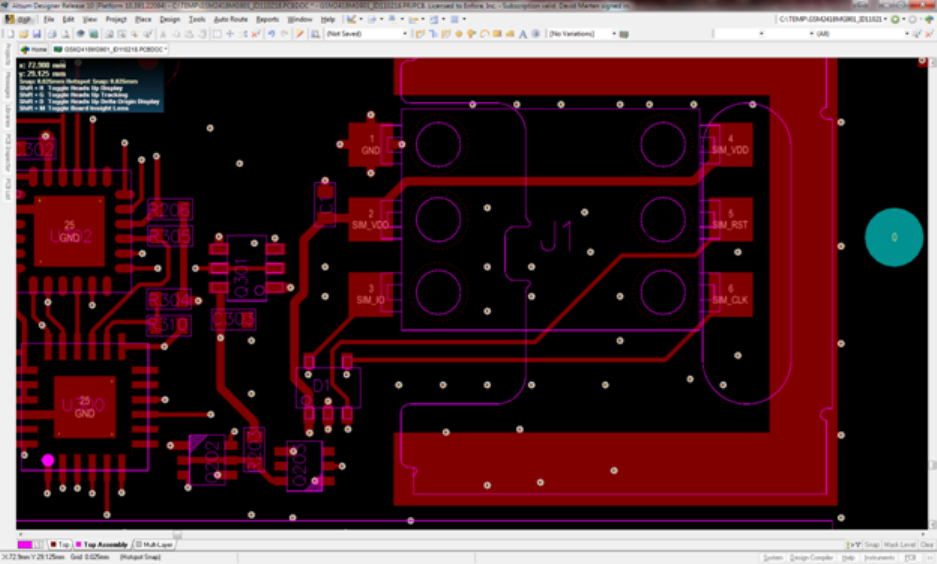
43 novatelwireless.com
Figure 3-12 Remote SIM Example

44 novatelwireless.com
4
Hardware Design
General Design Guidelines for Using Novatel Wireless M2M GSM Modules
Enabling the Transmission Modes for the GSM/GPRS Services
Voice Communication
Circuit-Switched Data
SMS: Short Message Services
Provisioning The SIM
GSM Services Supported by the Novatel Wireless M2M Enabler IIIG Module
GPRS Services Supported by the Novatel Wireless M2M Enabler IIIG Module
Selecting the GSM Modes of Operation

45 novatelwireless.com
General Design Guidelines For Using Novatel
Wireless M2M GSM Modules
The following guidelines are provided in an effort to allow Enabler IIIG module users to
successfully implement their PCB layout to obtain the best performance. This includes the
lowest possible EMI emissions, maximum thermal conduction, mechanical integrity, and voice
quality. The Enabler IIIG module is a very compact, high performance design, yet it is easy to
interface into the final product. In order to realize its full potential, designers should pay close
attention to ground structures, the routing of RF and Digital traces, and the size of the power
supply lines.
Warning: These design tips are strictly guidelines and are not meant to be a
complete list of items that guarantee actual performance. Each application is
different and may require variation from these guidelines, however, care should
be given to utilize these sound engineering principles whenever possible
Advanced Tips For An RF Friendly Layout
To ensure the lowest possible EMI emissions and maximum thermal conductivity, it is
recommended that all metal tabs on the GSM module shield must be soldered down onto a
continuous ground plane that runs under the entire module. Ample ground vias should be
provided around the metal tabs to create a low impedance ground. It is recommended to
minimize the number of I/O and power traces and vias under the GSM module to allow for as
much ground plane as possible. An example of a good ground structure and pad layout is
shown below in Figure 1.
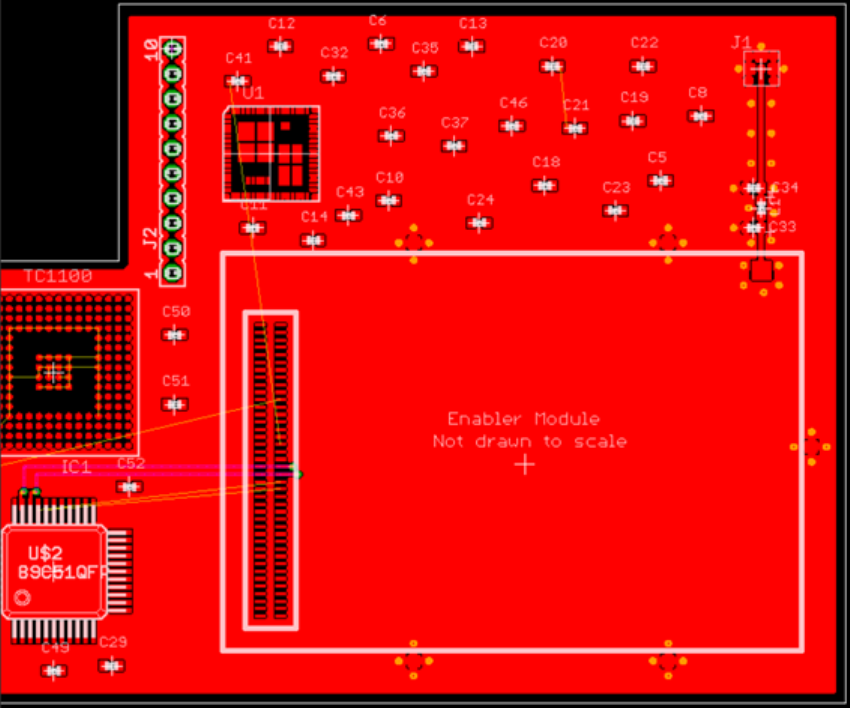
46 novatelwireless.com
Figure 4-1 Example of good ground plane for GSM modules
Thermal Relief
Because the ground plane acts as a large heat sink, it can affect the solderability of
components. A common method to reduce this effect is to use thermal relief around the pad
in question. However, great care must be taken when using thermal relief for high current or
high frequency applications
For example, a large thermal relief like the one shown in Figure 2 can serve the purpose for
general applications such as low current, low speed data lines, DC connections and audio
frequency applications. However, such thermal relief structures should be avoided for
applications where high current and/or high frequency is involved, such as those using the
Enabler Module. Depending on the frequency of operation, the long narrow thermal relief
traces between the pad and the ground plane act like an RF choke. These RF chokes become
higher impedance at harmonics of the fundamental frequency making it problematic for high
frequency suppression. This can make it difficult to pass type approval testing.
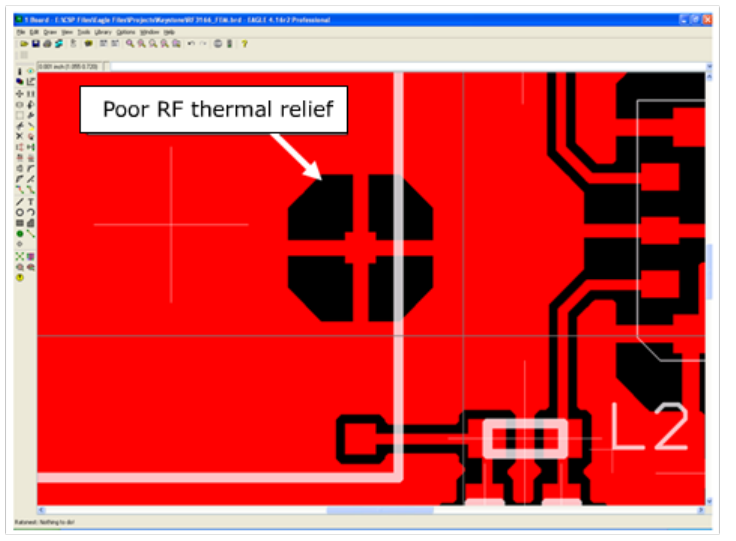
47 novatelwireless.com
Figure 4-2 Example of a POOR RF Thermal Relief
If thermal relief is necessary, it is recommended that you use short, fat traces similar to those
shown in Figure 3. This will still provide a solderable connection, while providing a better RF
connection. Making them shorter also allows for a more continuous ground plane due to less
copper being removed from the area. It is also recommended to have ground vias around all
thermal relief of critical ground pins such as the five Enabler shield tabs.
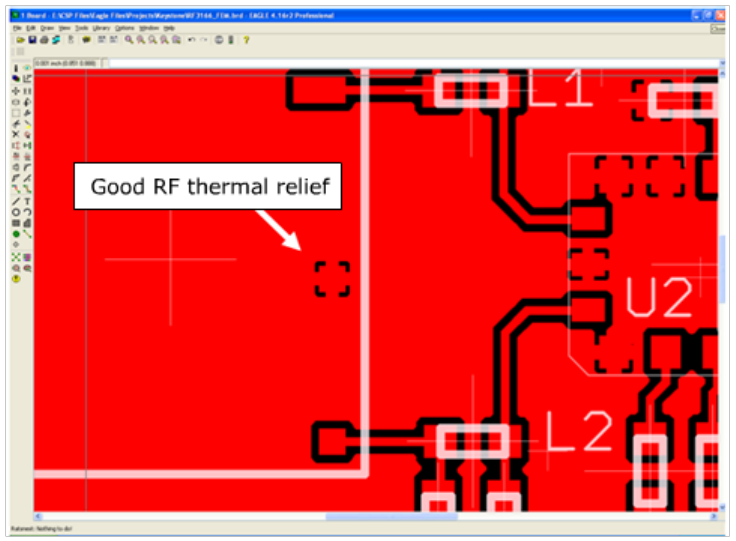
48 novatelwireless.com
Figure 4-3 Example of a GOOD RF Thermal Relief
Antenna And RF Signal Trace
The PCB trace that feeds the RF output port must be designed for a 50 ohm characteristic
impedance, coplanar, or routed into internal layers to keep the top layer continuous around
and underneath the Enabler module. Ample ground vias should be provided around the RF
contacts, the RF trace and launch pad. If possible, keep I/O and power traces away from the
RF port. This includes traces running parallel or orthogonal to it. Thermal relief should not be
used on the antenna output port ground pads. The designer must pay close attention to the
size of the pad and thickness of the dielectric beneath the signal pad and trace. Most PCB
manufacturers can adjust the trace width to maintain 50 ohms impedance if the traces are
identified and instructions are included on the FAB drawing. This service is typically provided
at no or minimal additional cost.
For minimum RF emissions due to the fundamental frequency of operation, the Enabler
module works best with an antenna load that has a VSWR of 1.5:1 or better. The antenna
should not have gain at the harmonic frequencies, otherwise, the conducted harmonics could
get amplified to a point where the product no longer passes type approval. However, for
49 novatelwireless.com
applications where antenna quality is less than ideal, it is recommended to have a low pass
filter (Pi structure with N=3) in the RF path to the antenna. This is a secondary plan should
there be a need to lower harmonic levels at frequencies above the PCS band. The pad
structure may also be used to match the antenna load impedance, if required. If it is not
needed, a capacitor of low reactance may be used to bridge the Pi structure.
The RF cable going between the Enable module and the antenna is very lossy, therefore, the
length of this cable should be kept as short a possible.
VBAT Input
The Enabler Vbat input can have a relative high current draw that can fluctuate rapidly,
especially when transmitting at max power and burst mode. The Vbat interface must be
designed to provide the required instantaneous voltage and current with minimal voltage
droop. This includes both sufficient bulk decoupling capacitance as well as adequate layout
provisions.
When laying out the connections to the Enabler interface connector, it is tempting to use
traces of the same width as the connector pins. However, this is a very compact connector
and traces of that width will not have sufficient copper. Similar to the discussion on thermal
relief, the use of narrow traces to connect the Vbat pins to the source voltage can act like a
high impedance and cause a significant voltage droop when higher currents are required as
shown in Figure 4.
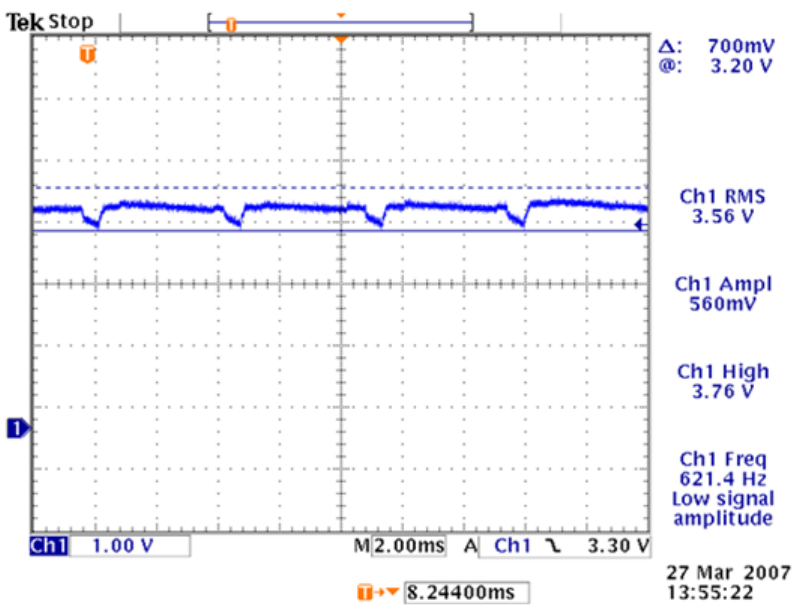
50 novatelwireless.com
Figure 4-4 Example of Vbat Voltage Droop
If the Vbat drops too low, the Enabler modules will reset. To minimize the trace loss, it is
suggested to use a larger trace that spans several pins as shown in Figure 5. Any concern
about solderability can be mitigated by using solder mask with cutouts for the individual pins
as shown by the blue lines in the figure. The layout should provide sufficient trace width over
the entire trace from the Enable modules all the way to the source of the Vbat voltage. Any
transitions between layers for this trace should utilize multiple vias.
Since even the best layout will have some impedance from the source to the Enabler module,
sufficient bulk decoupling capacitance is required at the Vbat input to the Enabler module. It
is suggested to use at least two 1000 uF, low ESR, tantalum capacitors located very close to
the Enabler interface connector Vbat pins. Any thermal relief used on these capacitors should
comply with the information given above in order to provide the lowest impedance possible.
The grounding of these capacitors is critical. Therefore, it should be a low impedance and
should utilize multiple vias to the internal ground plane close to the capacitor as well.
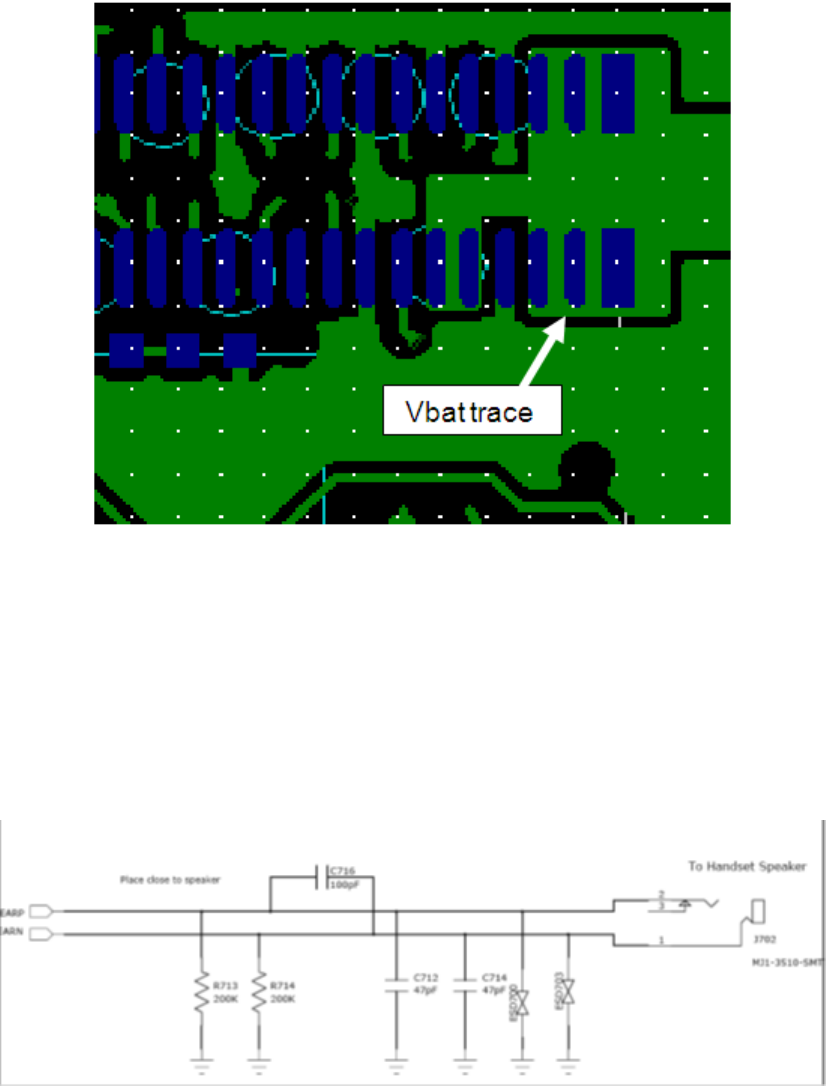
51 novatelwireless.com
Figure 4-5 Example of GOOD Vbat layout
Audio Reference Design
The audio quality is very dependent on the circuit design and layout. As an aid to obtaining
good audio quality, a reference design has been included below. It has been proven to
provide good performance on the SDK module.
Audio Schematics
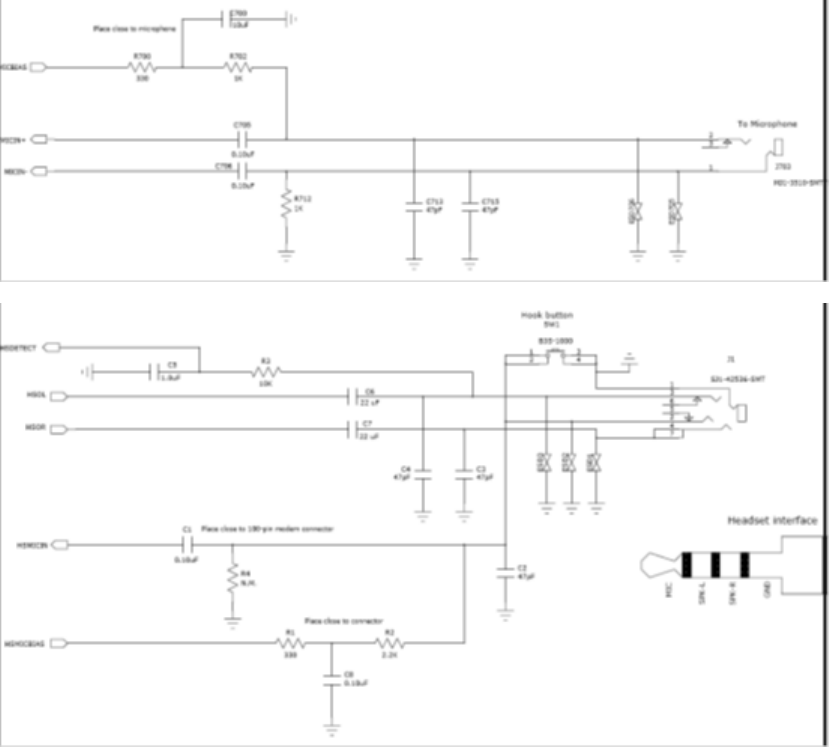
52 novatelwireless.com
Figure 4-6 Audio Reference Design Schematic
GSM/GPRS supports many optional services and modes. The Novatel Wireless M2M Enabler
IIIG module supports the following GSM/GPRS services:
l Circuit-switched data
l Short-Message Services (SMS)
l Class B GPRS Functionality
l Voice communication

53 novatelwireless.com
Enabling The Transmission Modes For The
GSM/GPRS Services
Each of the GSM/GPRS services has two modes that can be enabled separately:
Mobile-originated (MO): allows the making of a service request (such as, making a telephone
call or sending an SMS)
Mobile-terminated (MT): allows receiving a service request (such as receiving a telephone call
or an SMS)
Note: Contact your local GSM operator to ensure that the services and modes
have been provisioned for the SIM
Voice Communication
The Novatel Wireless M2M Enabler IIIG module has full voice capabilities, provided the
necessary connections have been made for the speaker and microphone pins on the 100-pin
I/O connector. The Novatel Wireless M2M Enabler-IIIG AT Command Set Reference -
GSM0308AT001 has the entire list of commands that can be used to control the voice
functionality. The quick start guide in this manual provides a basic command set that can be
used to initialize and test the voice functionality.
The Novatel Wireless M2M Enabler IIIG module supports four vocoder compression
algorithms for voice communication: Full-Rate (FR), Enhanced Full-Rate (EFR), Half-rate (HR)
and Adaptive Multi-rate (AMR).
Circuit-Switched Data
In this mode, the Novatel Wireless M2M Enabler IIIG module supports both of the connection
modes of transmission that are provided by GSM:
Non-Transparent mode delivers a constantly low error rate but with a non-guaranteed
throughput or delay. The Non-Transparent service provides a performance that is closest to
using a modem over a fixed Public Switched Telephone Network (PSTN) line.

54 novatelwireless.com
Note: All GSM service providers may not support transparent mode. In those
cases, the Novatel Wireless M2M Enabler IIIG module can be configured to switch
automatically to Non-Transparent mode. This capability depends on the settings
in the AT+CBST command.
SMS: Short Message Services
l Short Message Services (SMS) is a feature-rich GSM service. The Novatel Wireless M2M
Enabler IIIG module can perform the following tasks:
l Sending and receiving binary messages of up to 160 characters (7-bit characters)
l Sending and receiving text messages of up to 140 bytes (8-bit data)
l Submitting a SMS Protocol Data Unit (PDU) to a SMSC (Short Message Service Center)
and storing a copy of the PDU until either a report arrives from the network or a timer
expires
l Receiving a SMS PDU from a SMSC
l Returning a delivery report to the network for a previously received message
l Receiving a report from the network
l Notifying the network when the module has sufficient memory capacity available to
receive one or more SMS messages (after the module had previously rejected a
message because its memory capacity was exceeded)
Provisioning The SIM
The SIM can support optional features or services. Most operators typically configure the SIM
to send/receive voice calls and to receive SMS; however, some may require an additional tariff
to enable the SIM to send SMS. The transmission of circuit switched and GPRS data are also
additional services that may be required to allow the service:
l Mobile-originated (MO): allows making a service request (such as, making a call or
sending an SMS)
l Mobile-terminated (MT): allows receiving a service request (such as, receiving a phone
call or an SMS)
It is imperative for the Novatel Wireless M2M Enabler IIIG module that the SIM be configured
for the optional services that are required for the application.
GSM Services Supported By The Novatel Wireless
M2M Enabler IIIG Module
The Novatel Wireless M2M Enabler IIIG module supports four GSM services (modes of
operation) that must be enabled by the operator:
55 novatelwireless.com
l Voice calls (MO and MT): requires a telephone number
l SMS (MO and MT): uses the telephone number for Voice
l Circuit-switched data calls (MO and MT): requires a telephone number
l The GSM SIM can have multiple telephone numbers.
GPRS Services Supported By The Novatel Wireless
M2M Enabler IIIG Module
The Novatel Wireless M2M Enabler IIIG module supports the following GPRS (modes of
operation) that must be enabled by the operator:
l GPRS Packet Connectivity (MO and MT) with Both Dynamic and Static IP option
l GPRS SMS (MO and MT): uses the IP (Dynamic or Static) set by the operator
l Multiple APN Setting
l Quality of Service Options
l Multi-slot 10 Class of Service
Selecting The GSM Modes Of Operation
When provisioning the SIM for the Novatel Wireless M2M Enabler IIIG module, enable the
following modes of operation:
l Voice calls: configure the SIM for both MO and MT service (to send and receive)
l SMS: configure the SIM either for MT alone (to receive) or for both MO and MT (to send
and receive)
l Circuit Switched Data: configure the SIM either for MO alone (to send) or for both MO
and MT (to send and receive)
Voice SMS CS
Data GPRS Function
MO/MT MT MO Voice calls, receive SMS, make data
calls
MO/MT MO/MT MO Voice calls, receive / send SMS,
make data calls
MO/MT MO/MT MO/MT Voice calls, receive / send SMS,
make / receive data calls
(requires an additional data tele-
phone number)
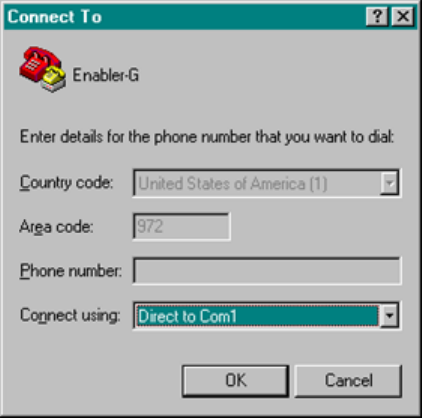
57 novatelwireless.com
General Setup
The GPRS modem is controlled through the Modem RS232 port on the development board.
Connect a 9-pin straight through serial cable from the Modem RS232 connector to the serial
port on the controlling computer.
Hook up power supply, connect antenna, and install SIM into modem.
Hyperterminal Configuration For The Enabler IIIG
Module
The following provides an example for setting up a Windows HyperTerminal session that can
be used to experiment with various configurations on the module for controlling computer:
1. Select the connection interface, Direct to Com 1 (or whatever port is the serial port).
Figure 5-1 Hyper Terminal Definition
2. Configure the COM port as displayed in Figure 21.
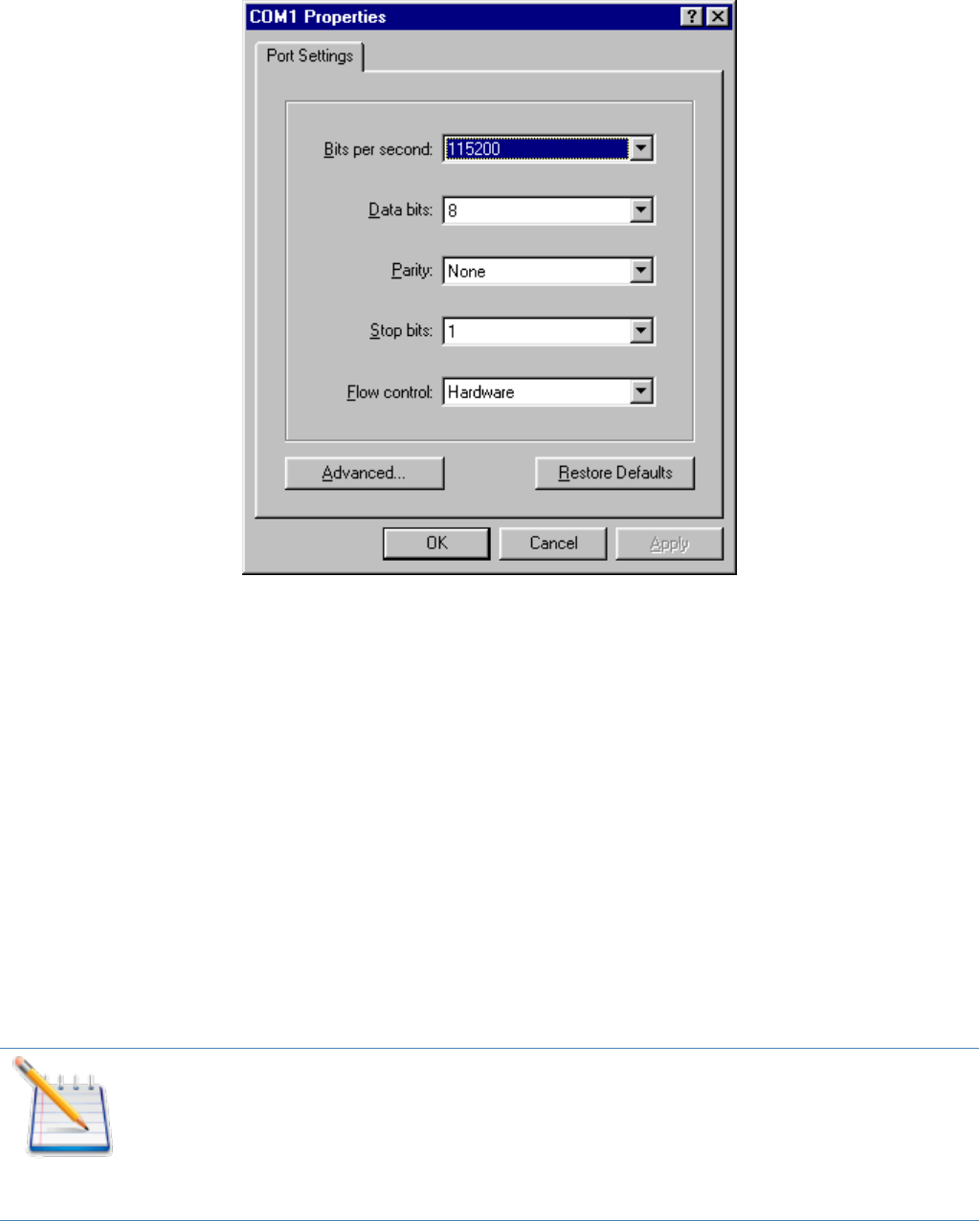
58 novatelwireless.com
Figure 5-2 COM Port Settings
Initialization (AT Command Interface)
In the GSM vocabulary, a call from GSM mobile to the PSTN is called a "mobile-originated call"
or "outgoing call". A call from the fixed network to a GSM mobile is called a "mobile-
terminated call" or "incoming call."
In the following examples, “Entry” refers to the application. The following convention
describes the direction of the data exchange:
l The data exchange from the customer application to the module is designated as: Entry
l The data exchange from the module to the customer application is designated as:
Response
Note: With the exception of the +++ command (Online Escape Sequence), all
commands must be preceded by the AT attention code (or command prefix) and
terminated by pressing the <CR> character.
In the following examples, the <CR> and <CR><LF> are intentionally omitted for
clarity and space.
59 novatelwireless.com
Initial Response To The AT Command
After power is applied to the module, the module performs a power-up self-test. The self-test
completes within one (1) second. When queried with the AT command, the module responds
with one of the following result codes:
l OK signifies that the module is ready, that it correctly interprets the AT command, and
that it has executed the command.
l ERROR signifies that the module does not understand the command or that the
command is invalid.
Entry AT
Response OK Command valid: module is ready
The module must be in AT Command mode when any command is entered (with the
exception of the online escape sequence). Commands entered when the module is in On-line
mode are treated as data, and are transmitted as such to the receiving module. (i.e. If the
module is in PPP or SLIP mode, AT commands cannot be entered.)
Sending An Initialization String To The Enabler
IIIG-BGA Module
The following example provides the sample AT commands and responses for the following
initialization tasks:
l Reset the module to the factory defaults
l Disable character echo
l Transmit Result Codes
l Set the module to Verbose mode (to display result codes as words)
l Set the DCD to match the state of remote modem
l Ignore the DTR
Entry AT&FE0Q0V1&C1&d0 Initialization string
Response OK Command is valid
Entry ATSO=1 Auto answer on 1st ring
Response OK Command is valid
60 novatelwireless.com
Setting Up The Communication Mode For The
Enabler IIIG-BGA Module
The following example sequence provides the AT command and response for setting the
Enabler IIIG-BGA module for full phone functionality, automated operator selection, 9600
baud, non-transparent mode.
Entry AT+CFUN=1 FULL phone functionality
Response OK Command is valid
Entry AT+COPS=0 Automatic operator selection
Response OK Command is valid
Entry AT+CBST=7,0,1 9600 baud, non-transparent mode
Response OK Command is valid
62 novatelwireless.com
The Novatel Wireless M2M Enabler IIIG module has been designed to minimize the amount of
time required for integration and testing the application. By being fully certified by the
appropriate bodies, the Novatel Wireless M2M Enabler IIIG module provides seamless
integration into the GSM network.
The integration issues for the application can be narrowed to the utilization of the AT
commands and the use of the GSM functionality. Coverage and signal quality may be
evaluated by using the RSSI commands. Additional network information can be determined
by using AT commands.
Integration of the GPRS Packet capabilities is more complicated than using AT command
sequences to initiate the connection and begin transferring data. The following Application
Notes should be used to integrate the GPRS packet capabilities:
l GSM0000AN001 - Enabler-G PPP Configuration for Windows 98
l GSM0000AN002 - Enabler-G PPP Configuration for Windows 2000
l GSM0000AN008 - Enabler-G PPP Configuration for Windows XP
l GSM0000AN010 - Enabler-G PPP Configuration for PocketPC 2002
l GSM0000AN005 - Enabler-G Automated Network Connection Configuration and Use
Integrating The Novatel Wireless M2M Enabler IIIG
Module
Note: Generally, all interfaces that are externally available to the end user need to be ESD-
conditioned and terminated in some way. Many of these interfaces should not be connected
with power applied.
At the highest level, this is done using some type of GSM test equipment (such as, Racal
6103E), a computer, and a serial interface tester. The GSM test equipment must be able to
simulate a GSM call and measure the key parameters related to the module.
Additionally, the serial interfaces and some minimal SIM functionality can be verified by
sending AT commands to the Novatel Wireless M2M Enabler IIIG module.
All of these conditions need to be verified at ambient as well as extreme conditions.
As part of integration, each of the following interfaces must be verified:
Information Recommendations
SIM The maximum line length of the SIM interface is 25.4 cm (10
inches).
The Novatel Wireless M2M Ena-
bler IIIG module takes care of
the signal conditioning
As a minimum, an external
application with a remote SIM
will require a standard SIM car-
rier.
63 novatelwireless.com
Filter the SIM VCC signal with
a 10 uf / 10 V capacitor to help
with the line length.
Primary and secondary serial
Interfaces
The Novatel Wireless M2M Enabler IIIG module uses a 1.8V
digital interface. The RS-232 signals must be level-shifted to
get standard levels. These signals must be ESD-protected.
Reset Interface Resets the Novatel Wireless M2M Enabler IIIG module when
tied low.
Audio/Microphone
Interface Preliminary balancing on Novatel Wireless M2M Enabler IIIG
module.
Maximum length TBD
Testing the following parameters verifies the RF parameters that may be affected by such
things as RF path loss, power supply noise, and external interference.
Functionality Parameters to be Tested
Transmitter Frequency Error
Phase Error
PA Ramp
Modulation Spectrum
RF Power Steps
Timing Advance
Receiver BER Based RX Tests (RXQUAL RXLEV)
BER Based Sensitivity
Testing the following GSM functionality verifies proper network communication.
Functionality Parameters to be Tested
Transmitter Frequency Error
Phase Error
PA Ramp
Modulation Spectrum
RF Power Steps
Timing Advance
Receiver BER Based RX Tests (RXQUAL RXLEV)
BER Based Sensitivity
Testing the following GSM functionality verifies proper network communication.
64 novatelwireless.com
Functionality Parameters to be Tested
Network Function Synchronization and registration
Call set-up and call termination (both MT and MO calls)
SMS and/or data calls
65 novatelwireless.com
Appendix 7 - Glossary And Acronyms
AMR Adaptive Multi-Rate
API Application Programming Interface.
App Application Refers to the Application which sends or receives
commands/responses from the HS 3001 Module
AT Command Set
Commands issued by intelligent device to a
modem to perform functions, such as to initiate
call, to answer call, or to transmit data.
Bit Error Rate
(BER) Bit Error Rate
CMUX
Multiplexer protocol that operates between an MS
and a TE and allows a number of simultaneous ses-
sions over a normal serial asynchronous interface
Customer Premise
Equipment (CPE)
A terminal in fixed location on the customer’s
premises.
Circuit Switched
Data (CSD)
Data link from a terminal through the network allow-
ing real-time, duplex connectivity at 9600
bytes/second.
dBi Decibels referenced to an isotropic radiator
Data Com-
munications Equip-
ment (DCE)
Data Communications Equipment
Digital Cellular Sys-
tem(DCS)
A collection of services and capabilities providing
flexibility of access and mobility through a com-
bination of wireless and wire-line networks, using
the 1800 MHz bandwidth.
Data Terminal
Equipment (DTE) Data Terminal Equipment
Enhanced Full
Rate (EFR)
Voice (vocoder) compression algorithms which
offer the highest quality voice communication.
Equipment Iden-
tity Register (EIR)
A database used to store International Mobile
Equipment Identity (IMEI) of a locally issued ter-
minal.
Equivalent Iso-
tropic Radiated
Power (EIRP)
In a given direction, the gain of a transmitting
antenna multiplied by the net power accepted by
the antenna from the connected transmitter.
Electromagnetic
Compatibility
(EMC)
The ability of a device to function satisfactorily in
its electromagnetic environment without inducing
intolerable disturbance to that environment (or to
66 novatelwireless.com
other devices)
Electrostatic Dis-
charge (ESD)
Static electricity that can damage electronic equip-
ment.
European Union
(EU)
An organization of 15 European states whose pur-
pose is to organize relations between the Member
States and between their peoples.
Full Type Approval
(FTA) CDMA Full Type Approval
General Packet
Radio Service
(GPRS)
Standard for packet communications utilizing
Code Division Multiple Access (CDMA ) infra-
structure.
Code Division Mul-
tiple Access
(CDMA )
Standard for digital communications. Allows con-
sistent communications in various parts of the
world despite variations in RF spectrum alloc-
ations. Transferring the SIM (see below) permits
users to roam by changing terminal equipment.
Home Location
Register (HLR)
Stores the identity and user data for all subscribers
belonging to the area of the related MSC.
International
Mobile Equipment
Identity (IMEI)
A unique number for each CDMA Terminal tracked
by the CDMA operators in their Equipment Identity
Register (EIR) database.
International
Mobile Subscriber
Identification
(IMSI)
A unique number identifying the subscriber stored
in the SIM card. Number is used in conjunction with
the network for call routing.
Ki A secret code used in authentication and encryp-
tion by the terminal.
Mobile Originated
(MO)
Any CDMA service originated at the mobile ter-
minal.
Mobile Terminated
(MT)
Any CDMA service originated from or routed
through the network and sent to the mobile ter-
minal.
Mobile Switching
Center (MSC)
The central switch of the CDMA network. Performs
call routing, collects call detail records for billing,
and supervises system operations.
Non-Transparent
Mode
Delivers a constantly low error rate but with a non-
guaranteed throughput or delay. The Non-Trans-
parent service provides a performance that is
closest to using a modem over a fixed PSTN line.
Nationally Recog-
nized Test Lab-
oratory (NRTL)
OSHA-approved Nationally Recognized Testing
Laboratory
67 novatelwireless.com
OEM Original Equipment Manufacturer
PA Power Amplifier
Packet A collection of data transmitted over a digital net-
work in a burst
CDMA Personal Communication Services
PDA Personal Digital Assistant
PDU Packet Data Unit
PPP Point-To-Point Protocol
SIM Subscriber Identity Module
SMS Short Message Service
SMSC Short Message Service Center
SUPL Secure User Plane Location
UDP User Datagram Protocol





